-
Posts
2,390 -
Joined
-
Last visited
-
Days Won
8
Content Type
Profiles
Forums
Events
Posts posted by habigman
-
-
On 6/7/2023 at 1:37 PM, ImagineHat said:
I searched in the Lehmann Vienna Address Directories and Austrian National Library newspapers (ANNO) but unfortunately she wasn't listed. Any suggestions on other directions or where else to look?
Sorry for the late reply. I found this hutmacher (men's Stiff Felts) that worked for P. & C. Habig Wien but I can't remember how I found the address book.
I will have to go back and see if I can find it again.
I will send you a P.M. with my email so you can contact more easily.
-
On 9/15/2022 at 10:26 AM, T Sherman said:
Sorry for my very late reply. Some how I missed your post. This is a Silk Plush Top Hat. It was sold by J. A. Seidl, Munich. My guess is it 1890s into the early 1900s. Can you check for a paper label behind the sweatband?
-
On 5/30/2023 at 2:04 PM, ImagineHat said:
Thank you for checking, I really appreciate it. She was also a verkäuferin (saleswoman), so presumably she worked in a shop (as opposed to a factory).
Women's hats were mostly fashion oriented and made by milliners in shops. It's possible she might be listed in an address book. Have you been able to find her in any address books?
-
On 5/17/2023 at 7:48 PM, Debra said:
Do you know where I can find an official hat from this factory with the PH Moëckel tag? Our family was hatters from Germany and we have been looking to buy one for 30+ years.
I believe this is the only original PH. Möckel Hutfabrik, Homburg vor der Höhe I personally have so very difficult to find.
The other originals posted here belong to Gotisches Haus (Gothic House) Bad Homburg , Germany.
PH. Möckel Hutfabrik, Homburg vor der Höhe went out of business in 1931 and later in the 1930s the trademark was used by distributor Wilhelm Ispert Köln. This advertisement is from the December 15, 1936 edition of Deutsche Hutmacher Zeitung.
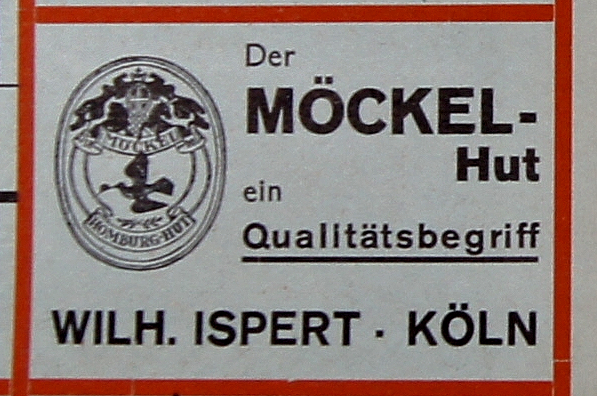
I believe this a later PH. Möckel distributed by Wilhelm Ispert Köln. I don't know the hat company Wilhelm Ispert Köln used as a source.
-
On 3/26/2023 at 10:39 PM, ImagineHat said:
Hello,
I’m doing genealogy research and am looking for information on Elsa Spiegel, a milliner (modistin / modist / hutmacherin) in Vienna during the 1920s-1940s. I’ve searched through some of the resources on this site, but didn't come across her name. I’d be very grateful if anyone could share historical resources (trade magazines, industry newspapers, directories, etc.) from the time - it would really help me in my research.
Thanks in advance!
I couldn't find her name in the Vienna section of the Austrian Hat Industry Guide (1926) but its focus was the Austrian Men's Felt Hat Industry.
I have some copies of the Austrian Hat Makers News (also focused on the Men's Felt Hat Industry) from that time period and some other info I can check. The larger companies made felt hoods and capelines which they supplied to women milliners that made women's felt hats. Some of the companies made women's felt hats but they were based mostly on men's styles.
-
Mayser "J.K.", 57 cm, 115 grams, possibly late 1920s. The exterior Size Stamp is 58 which is accurate. The black Felt is of high quality and finely Finished. Interesting shorter length Bow which appears to be a Mayser Ulm trademark (based on my three Mayser Ulm Stiff Felts). The Liner has slightly transparent lightweight sides. Anton Ils Neiderlage / Warehouse was out of Ulm a. /D. so same location as Mayser Ulm. I have Silk Top Hat from Anton Ils Ulm a. / D. Came with a very nice light weight Case.
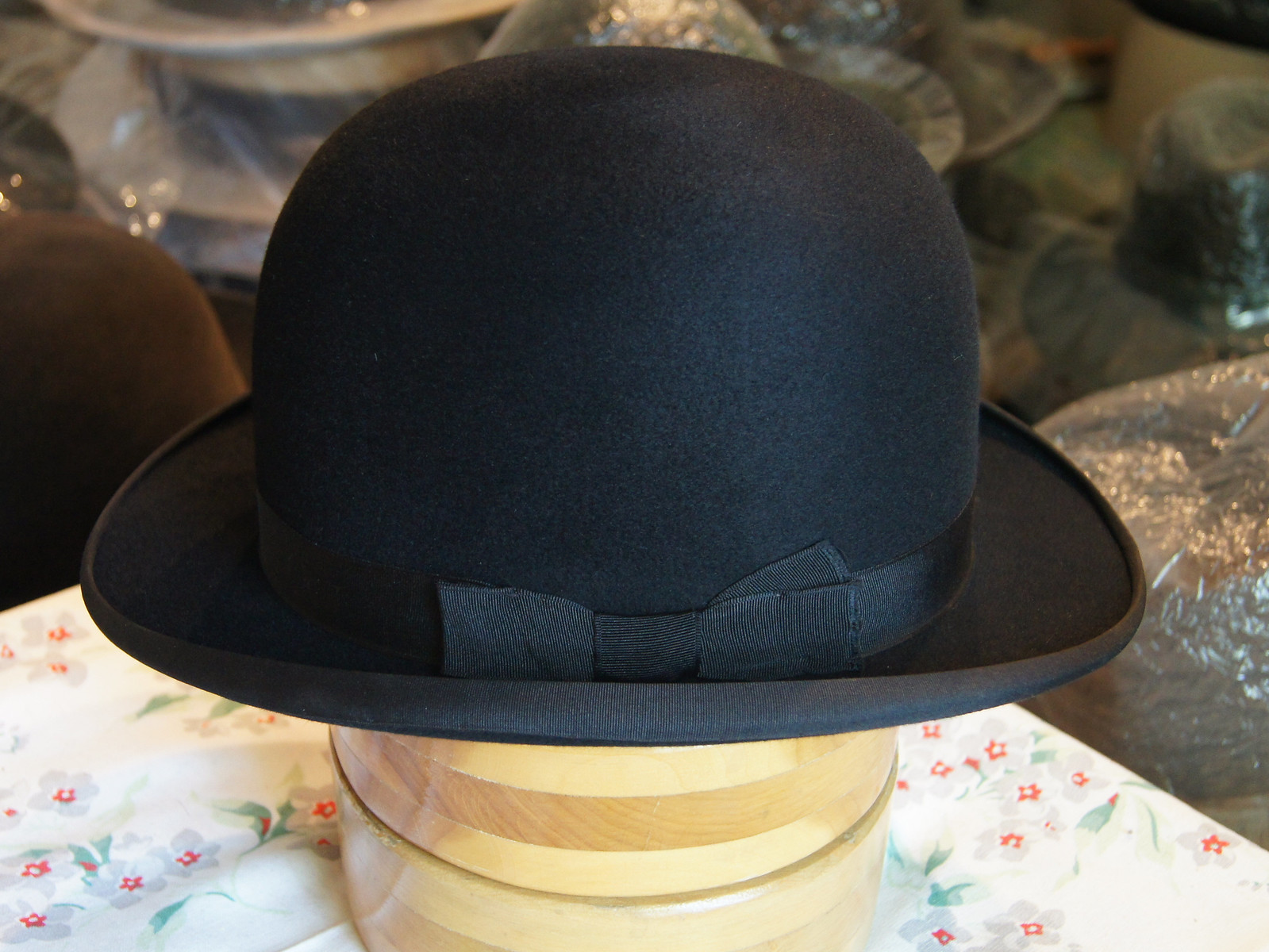



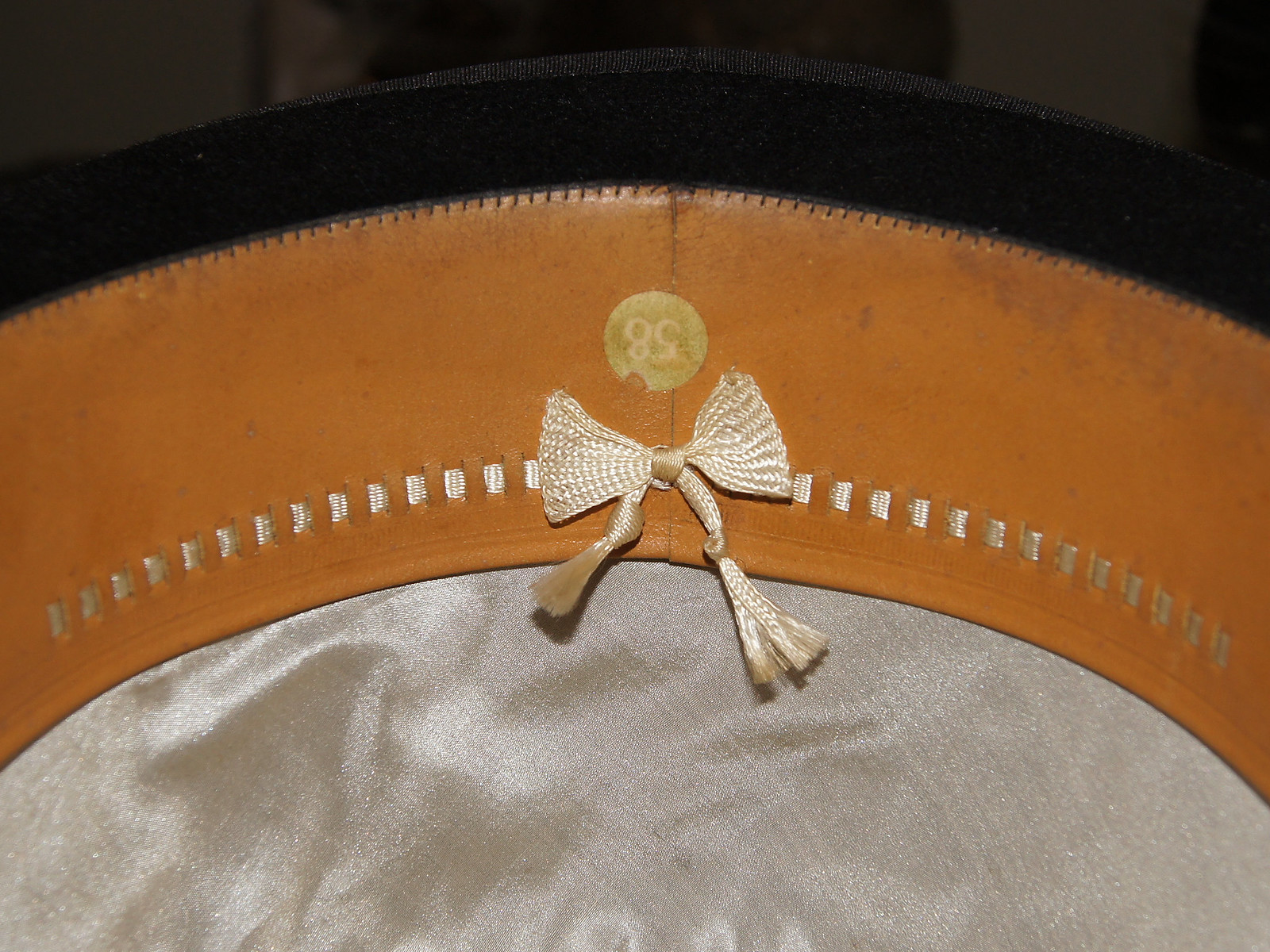
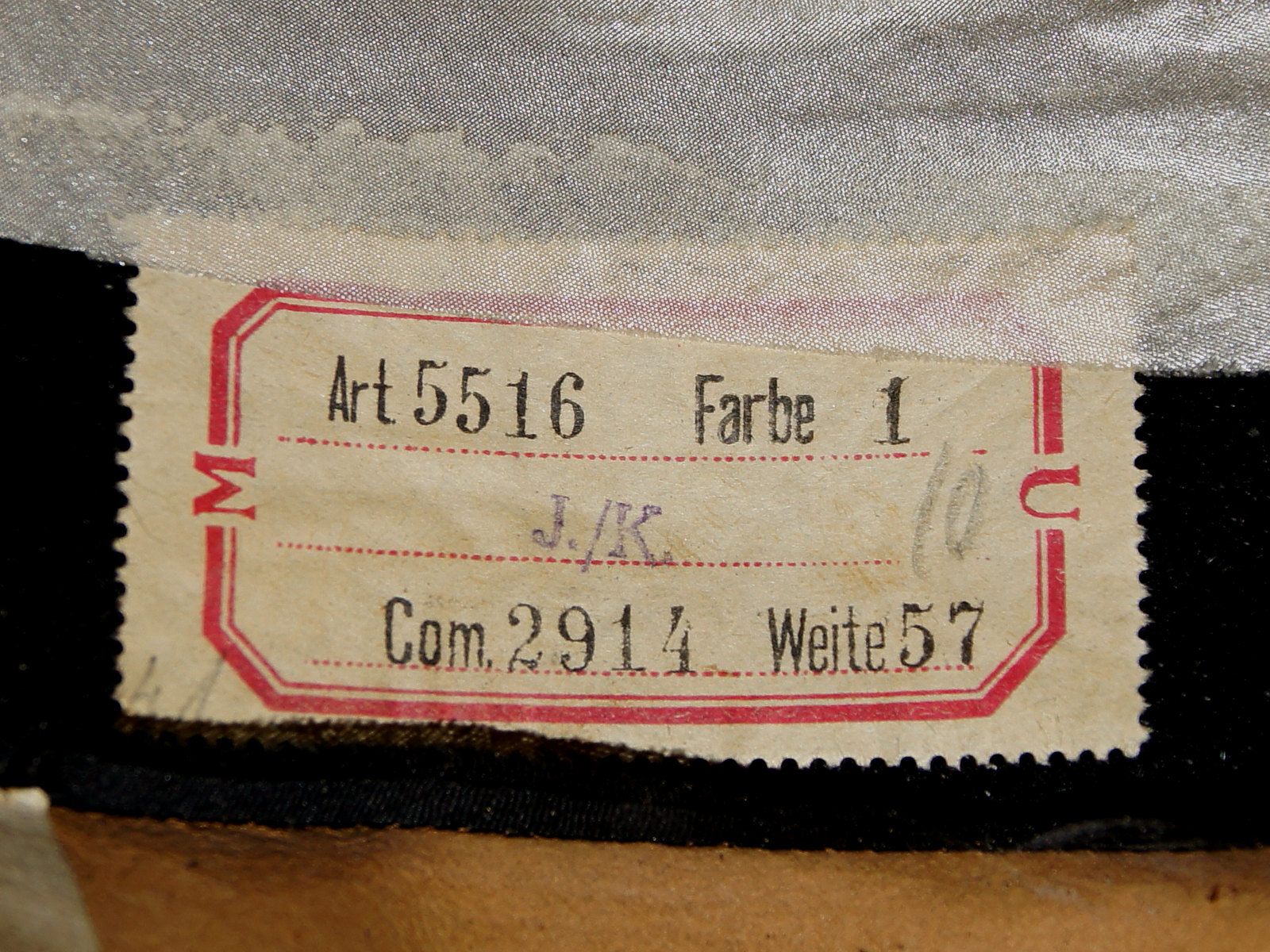
Natural Light
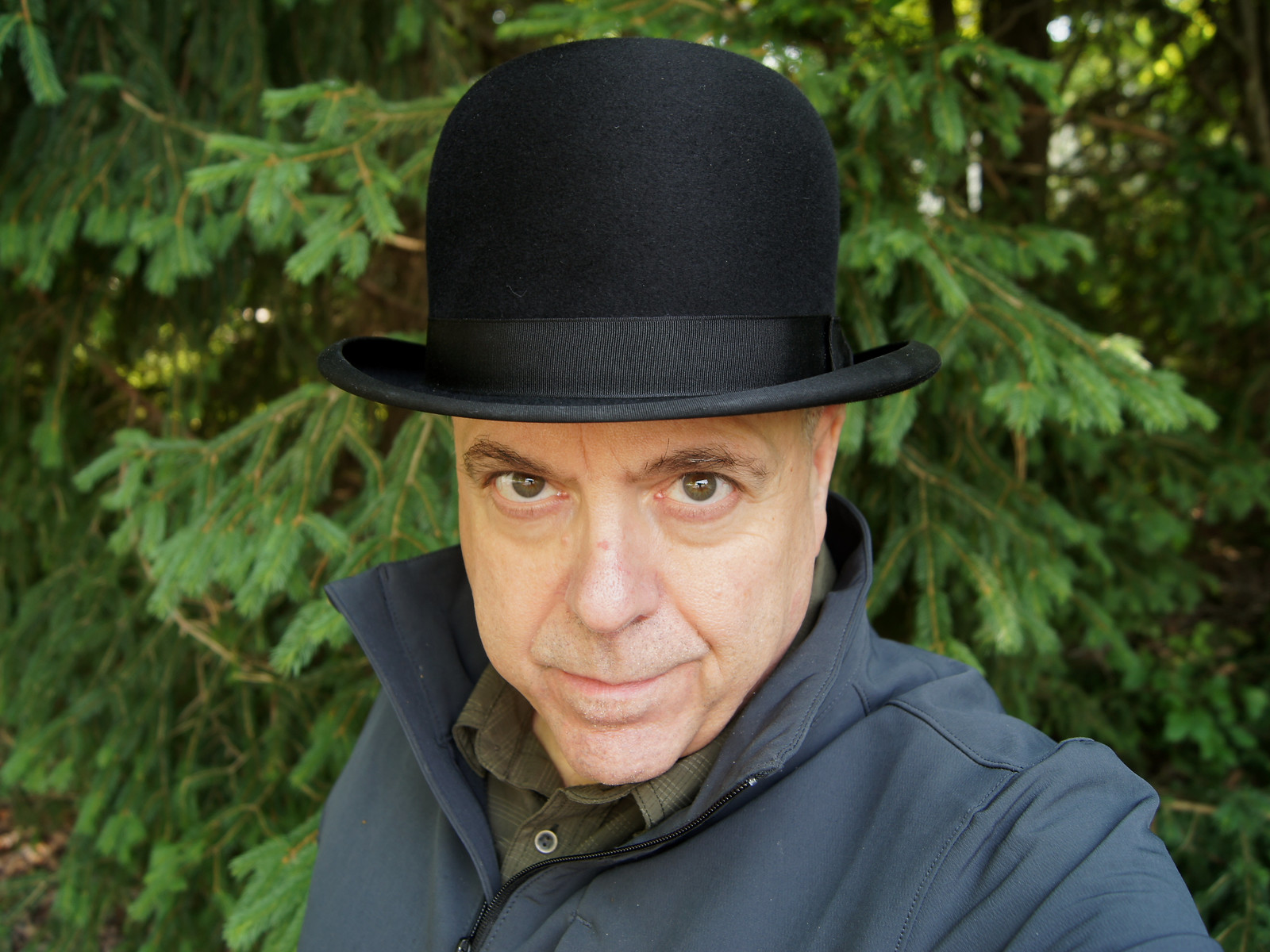

Light Weight Case
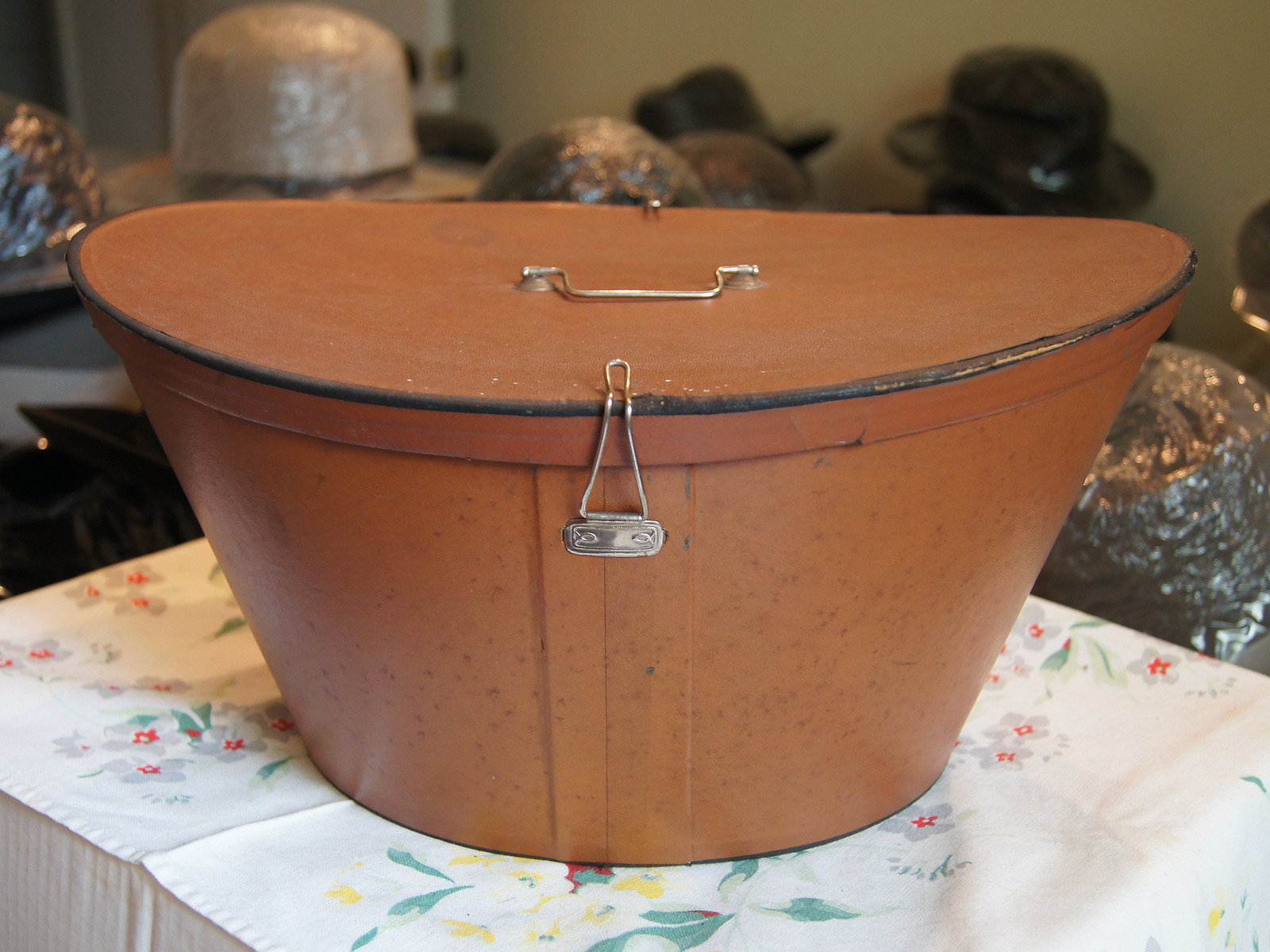

-
On 12/20/2022 at 3:04 AM, Anita N said:
Hello Anita, Sorry for the late reply. Great looking P. & C. Habig Wien Soft Felt Hat! A seamstress should be able to reinstall the Reeded Sweatband. Just copy the stitching that remains. You might be able to do it yourself if you have a sewing background.
-
J. Hückel´s Söhne "Aero" "Rauh", FP 5 1/2, possibly late 1920s early 1930s. Everything about this one is fantastic. This hat belongs to Wangenheim on the FL.
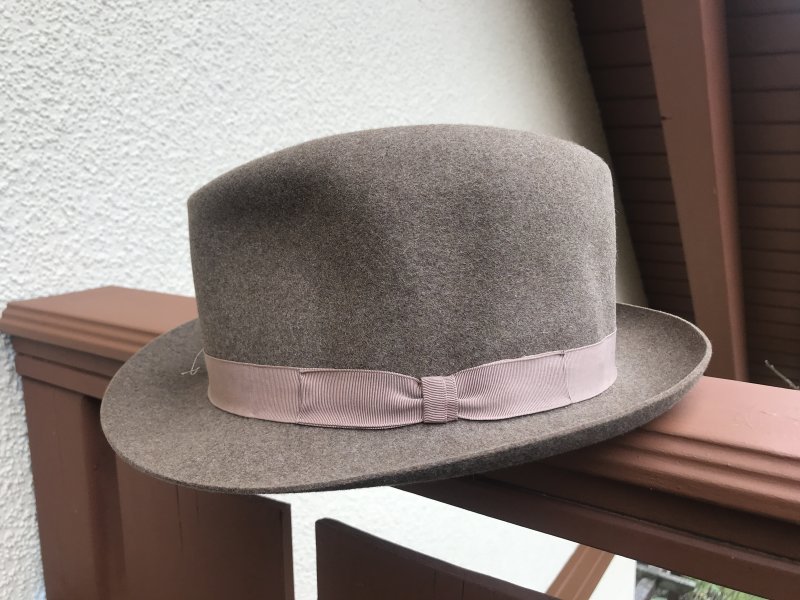
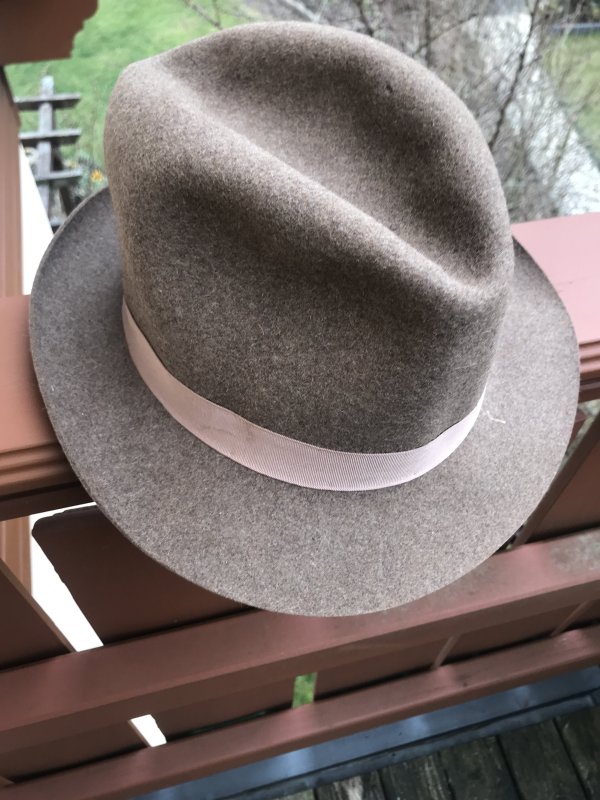
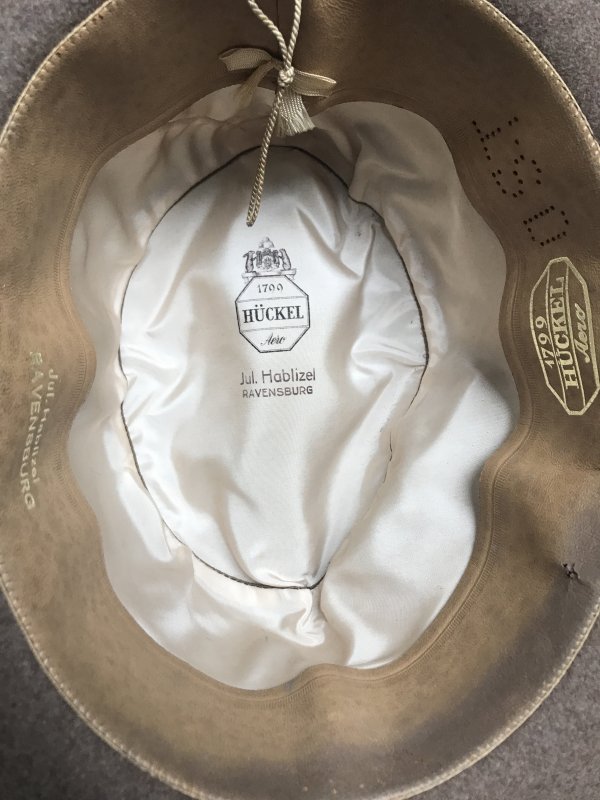
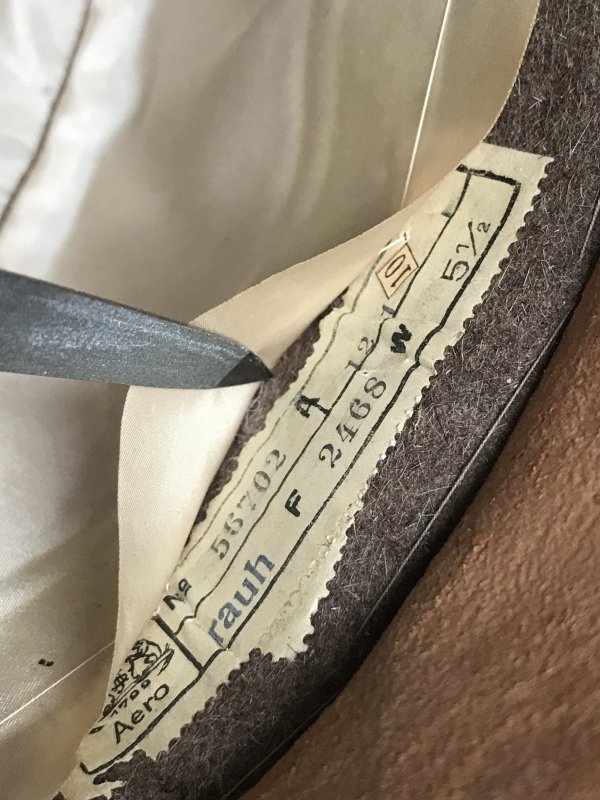
-
J. Hückel´s Söhne "Standard" "Crystall Velour", FP 5 1/2, possibly late 1920s early 1930s. This beauty belongs to Wangenheim.
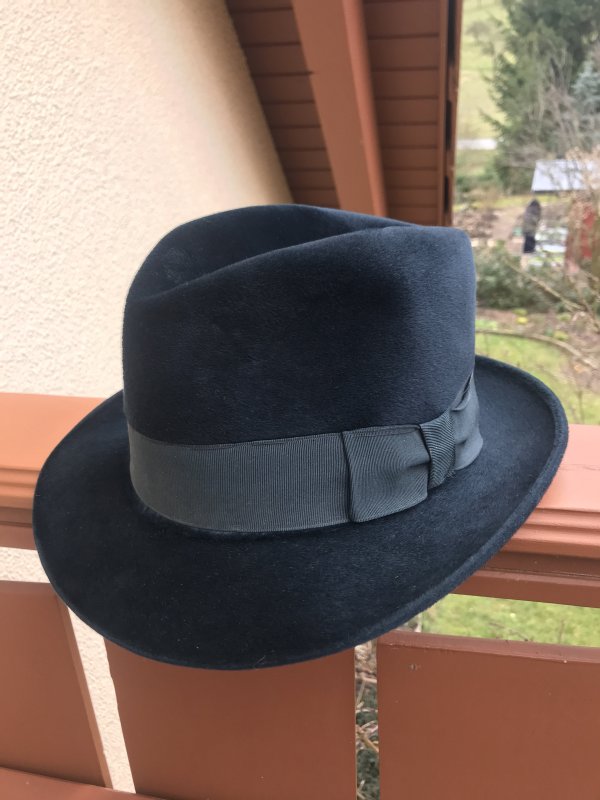
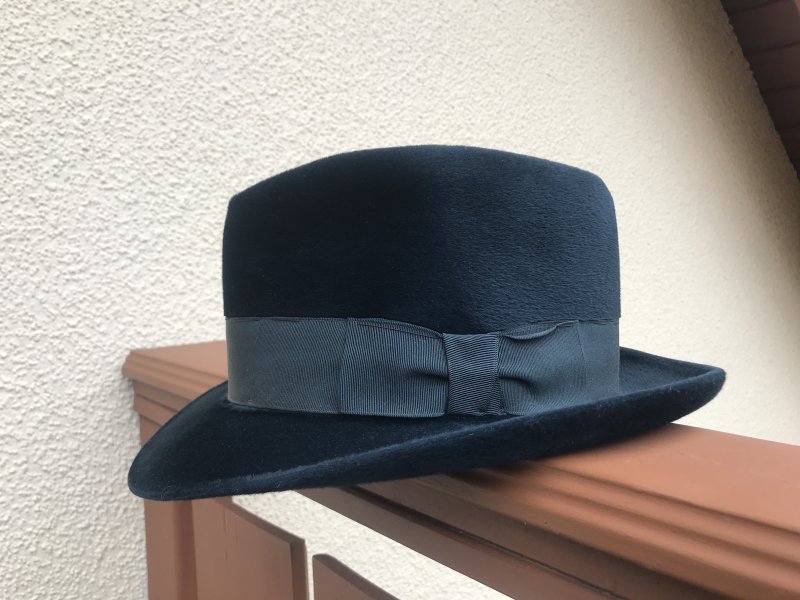
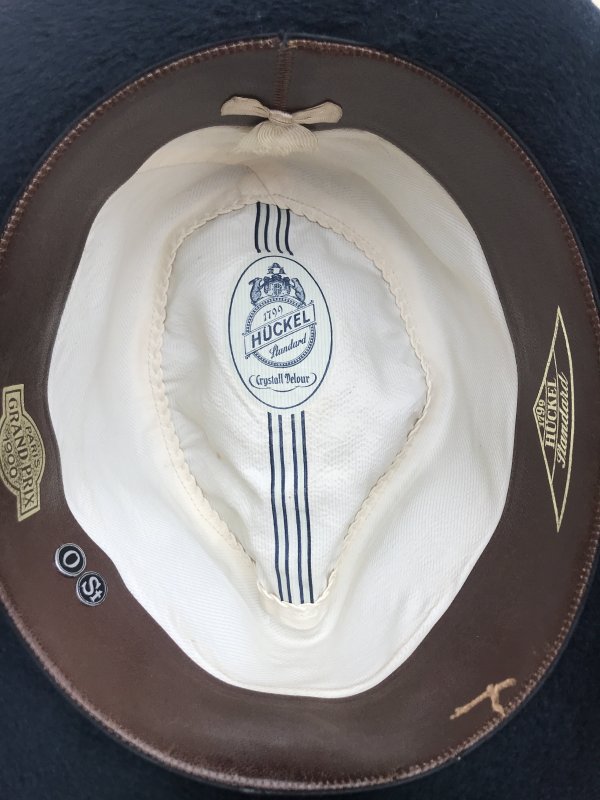
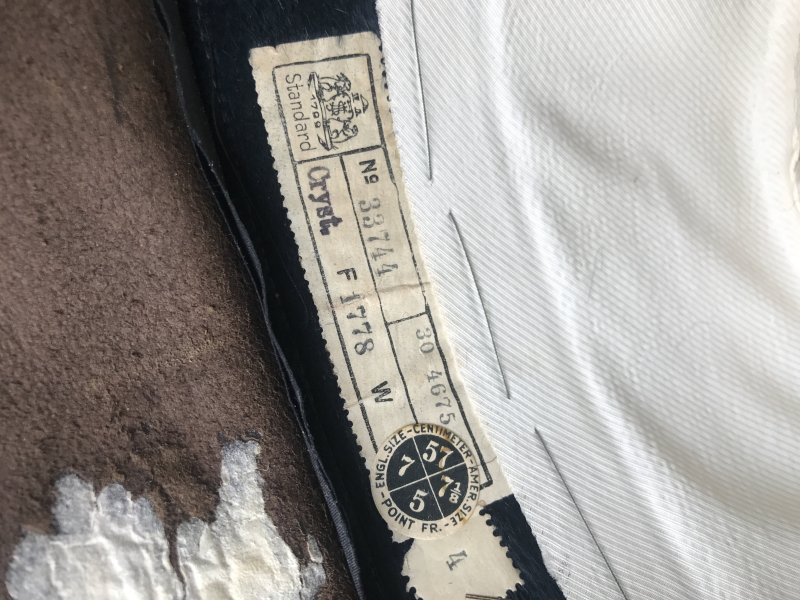
-
C. G. Wilke Guben "Trumpf", 54 cm possibly late 1920s early 1930s. This fantastic hat belongs to Martin.
-
P. & C. Habig Vienne "Sport" "Special Quality", 59 cm, with Ventilo, production year 1955. Made for the French Market. This hat belongs to Stefan on the FL.
Ventilo
-
J. Hückel´s Söhne "Standard" "Crystall Velour", FP 5, possibly late 1920s early 1930s. This fantastic Velour belongs to Stefan on the FL. Here are some of his additional comments. "The raw edge brim at 6cm and the crown at 10,5cm at the center dent. A few tiny nicks aside the felt is in excellent condition. Missing its liner though and the bow needed some correction as well. The hand of the felt is everything you'd expect from a Hückel velour."
-
J. Heinr. Ita Wien "Super" "Extra Qualität", 55 cm possibly late 1950s. Very nice pliable black Felt that easily dry creases. High quality components and workmanship. The overall condition is NOS. J. Heinr. Ita Wien were well known high quality Vienna made hats but they more difficult to find. This one was a seller size mistake.

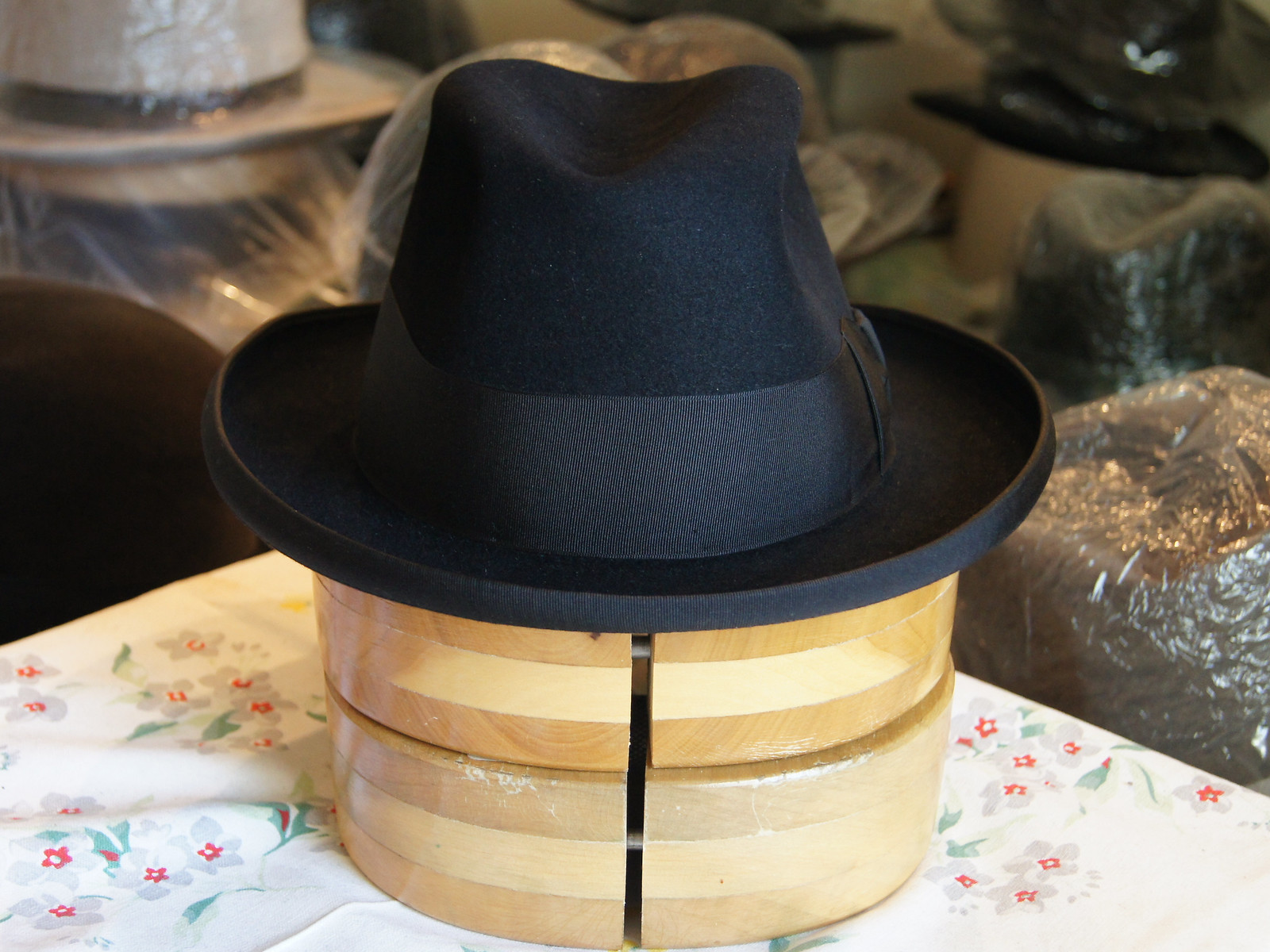
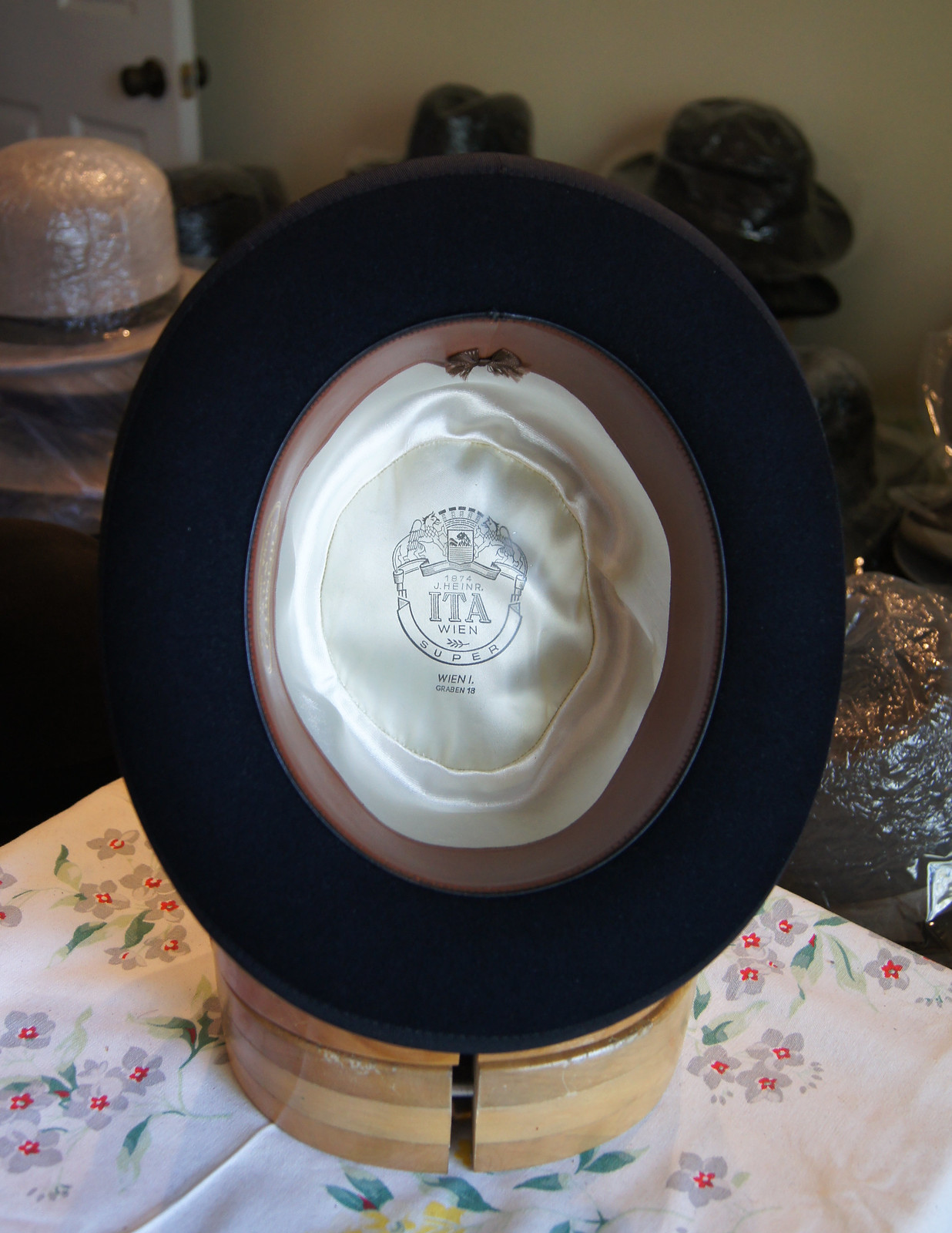
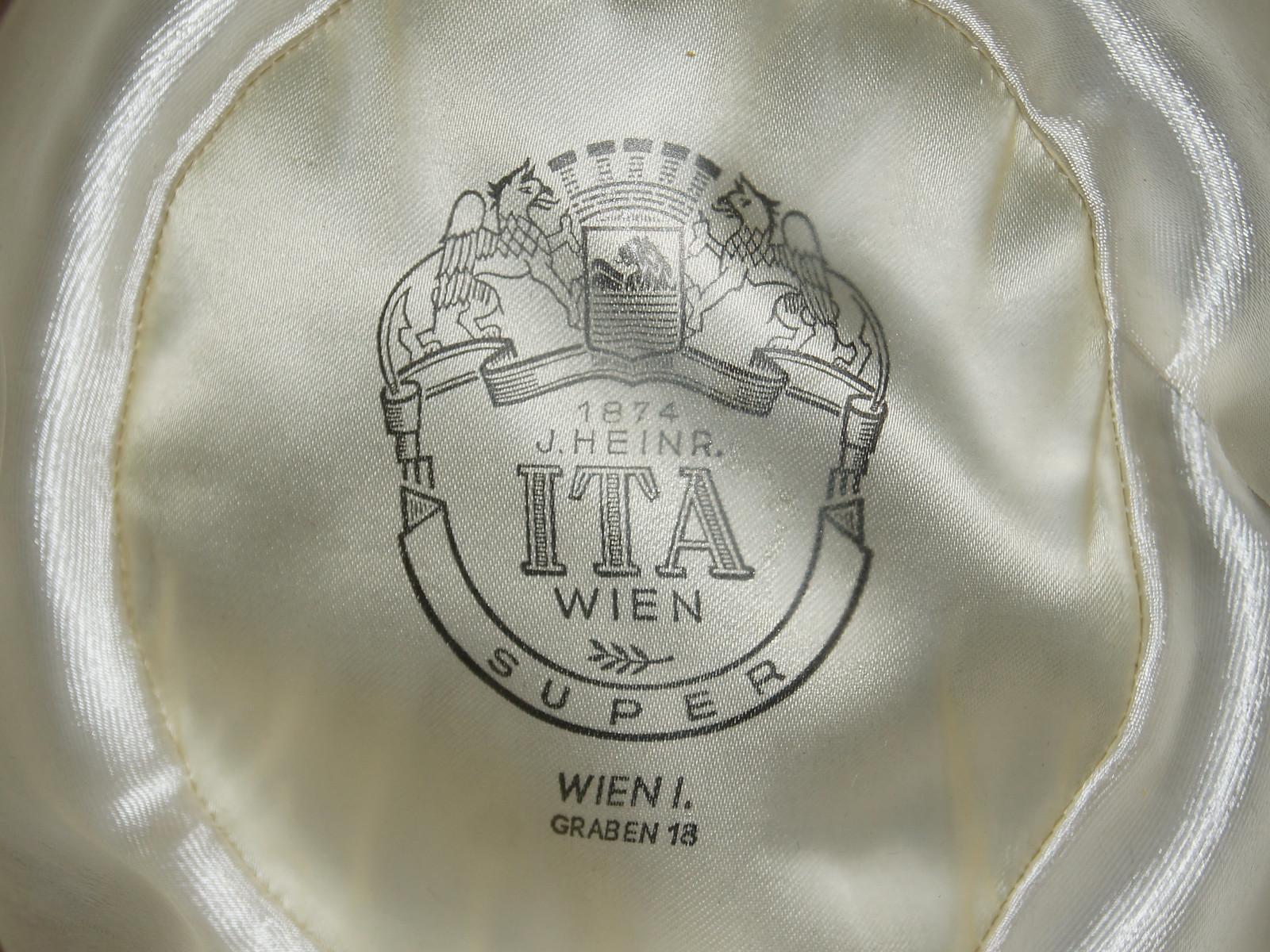

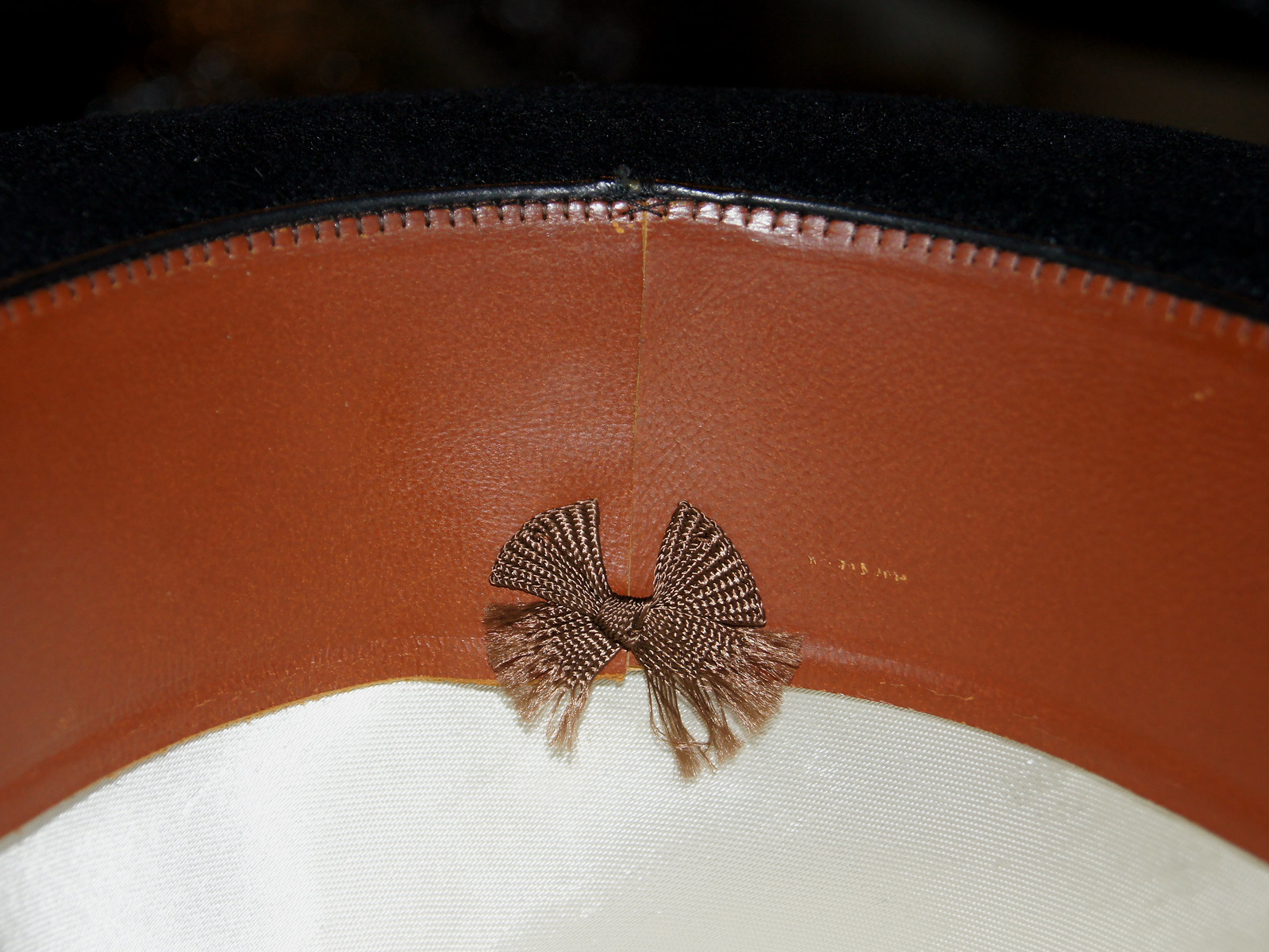
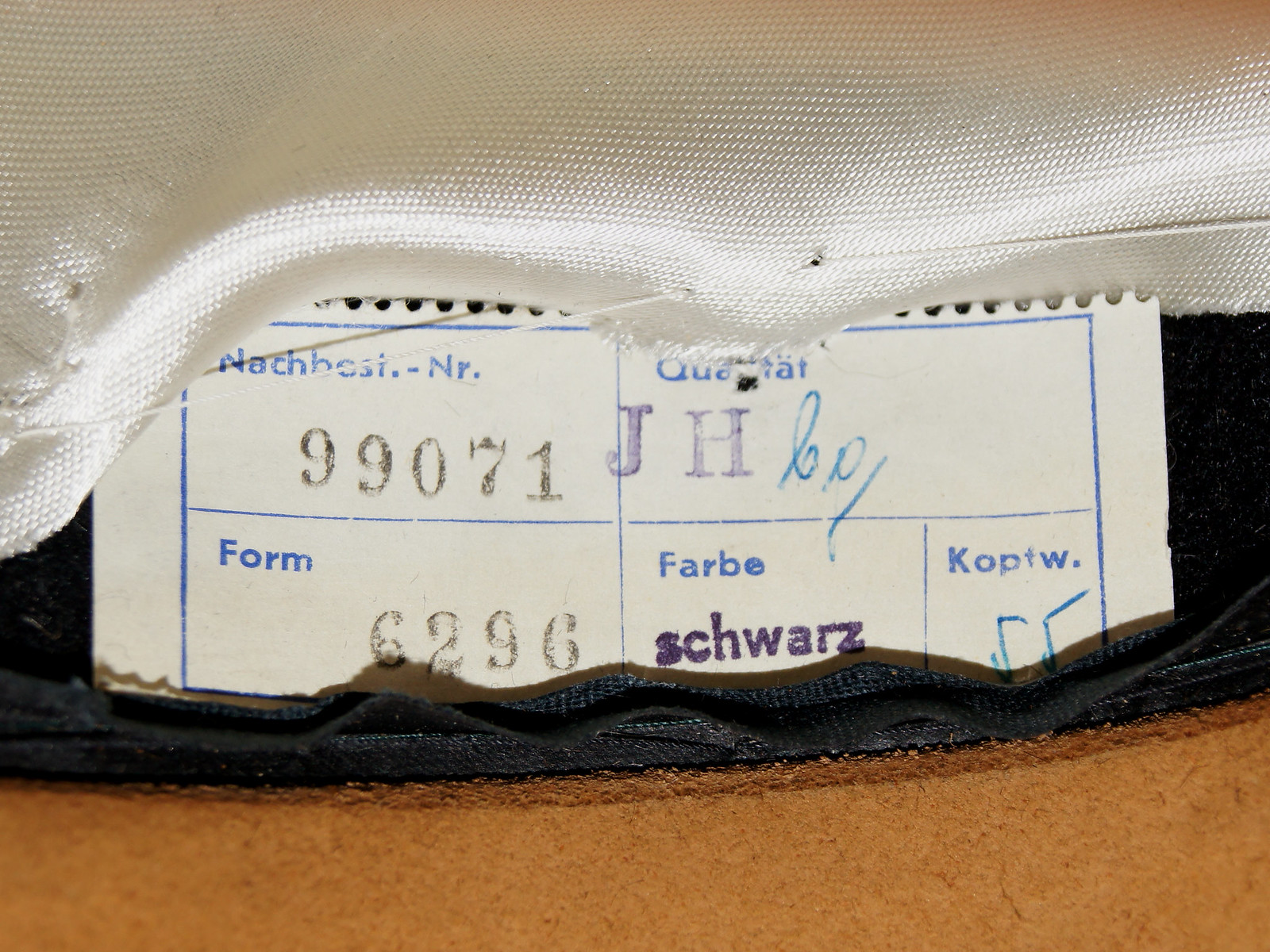
Open Crown

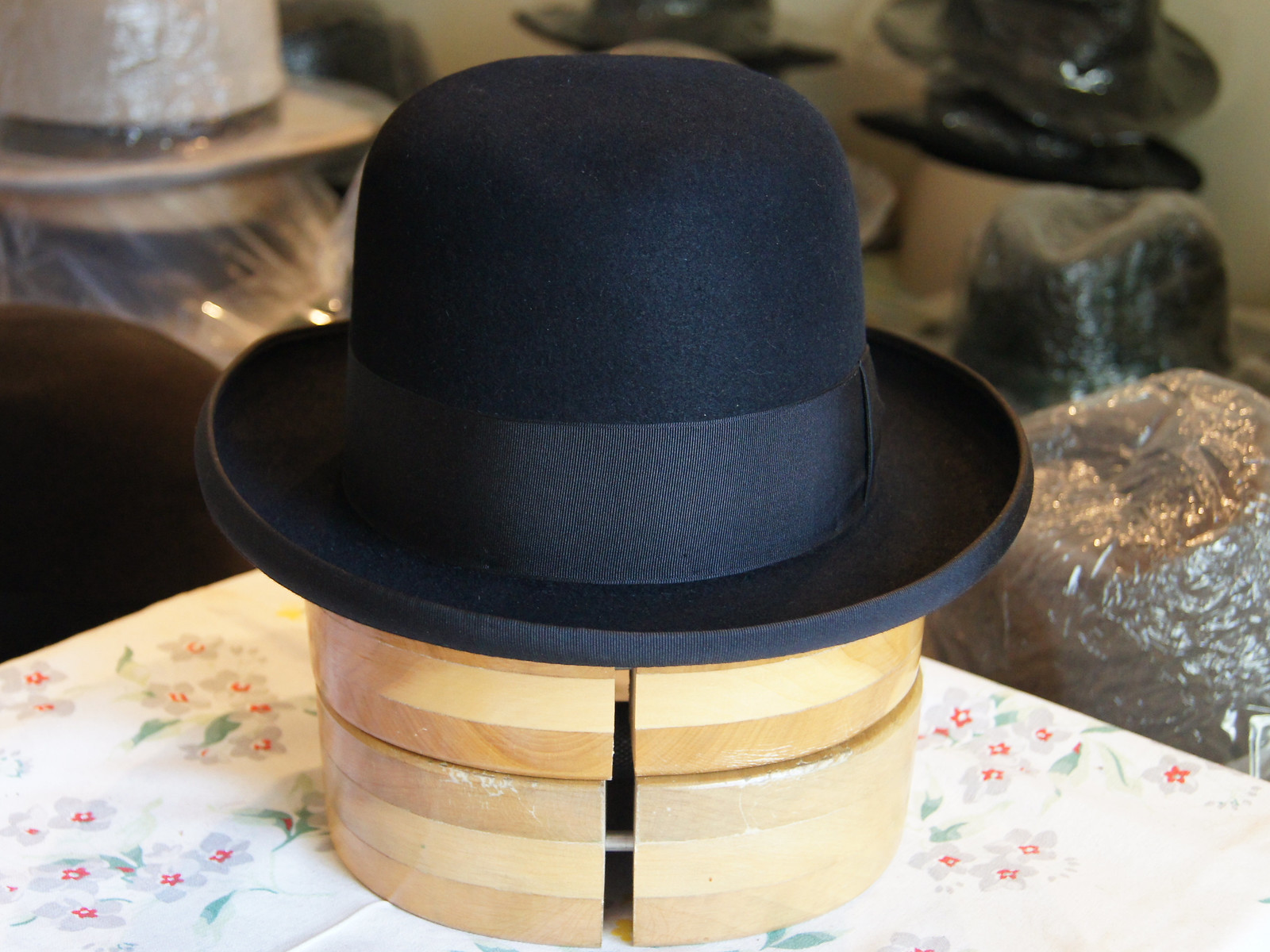
-
On 12/16/2022 at 1:15 PM, Judyta said:
Judyta,
Sorry I missed your post. This Soft Felt Hat was made by Hückel Weilheim Germany possibly late 1960s very early 1970s. Hückel Weilheim was founded in the late 1940s by former employees of the JHS Ratibor factory.
-
Martin, Thanks!
-
 1
1
-
-
J. Hückel´s Söhne "Plume", 58 cm, F.P. 5 1/2, 128 grams possibly early 1930s maybe late 1920s. The Stiff Felt came with an original J. Hückel´s Söhne internal wood frame Cardboard Box (see below) which is something I have been looking for many years. The Stiff Felt is in mint condition and overall is really fantastic (one of my finest). The black Felt has a great finish and is light in weight. The black Liner has a gold embossed JHS Crest that is offset by a off white textured + decorated Sweatband. The Bow design is unique + striking. Also came with a JHS external Paper Size Tag (see below) which is also an item that I have been looking for a long time. The shop that sold all this was located in Užhorod, Czechoslovakia which was part of the Austrian Hungarian Empire up to 1919 and today Ukraine. This all came from a Czech source.
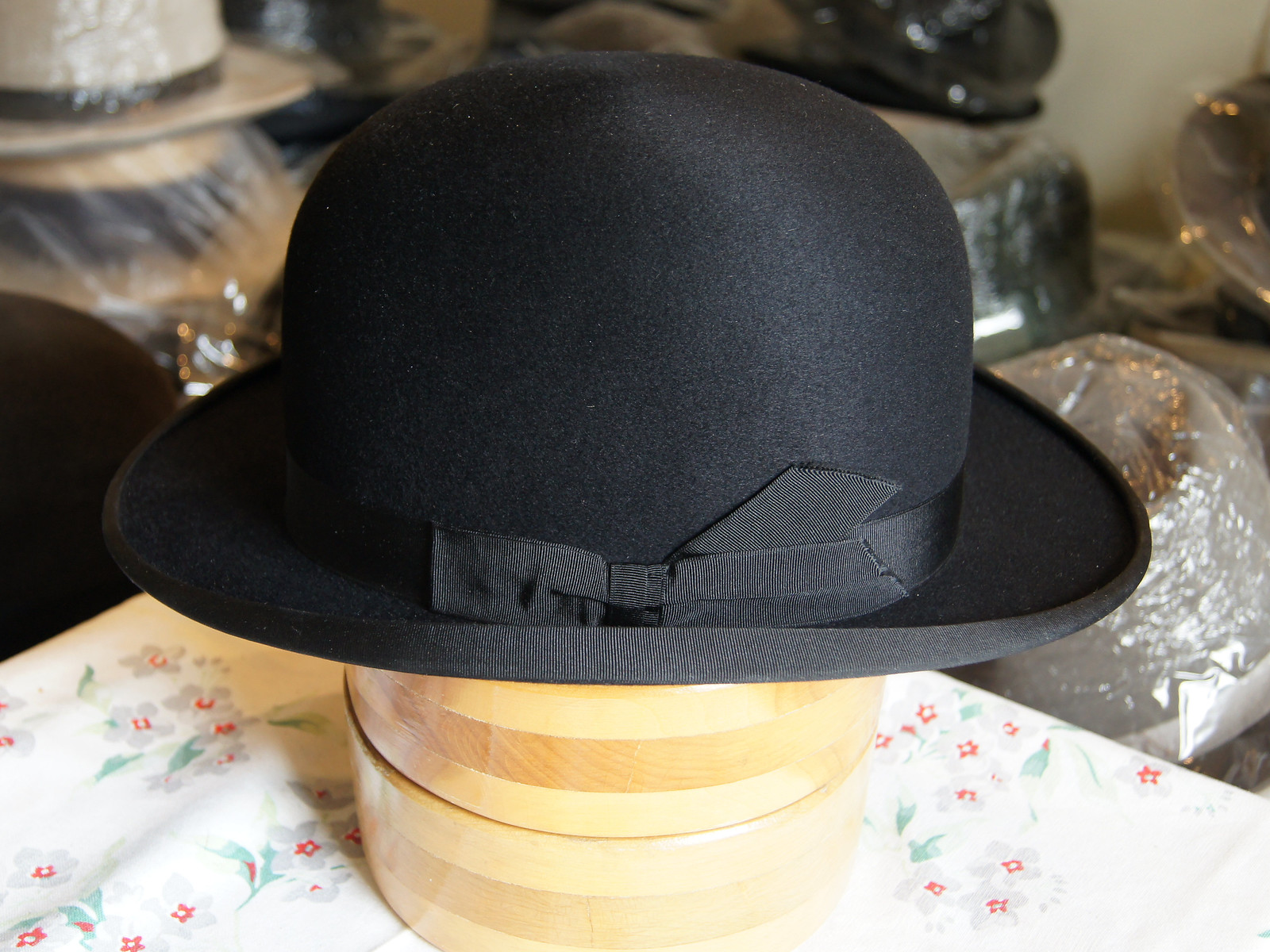
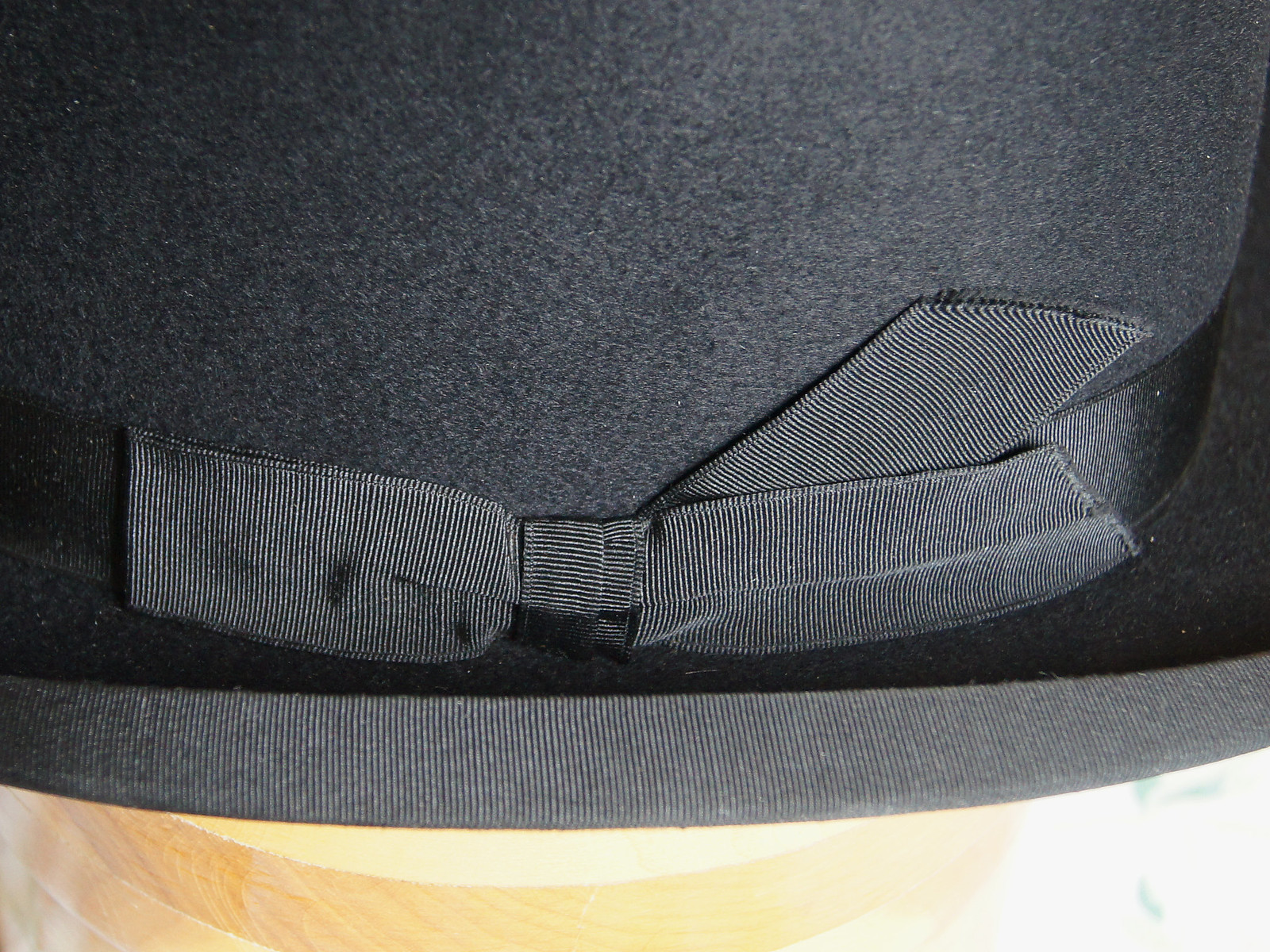
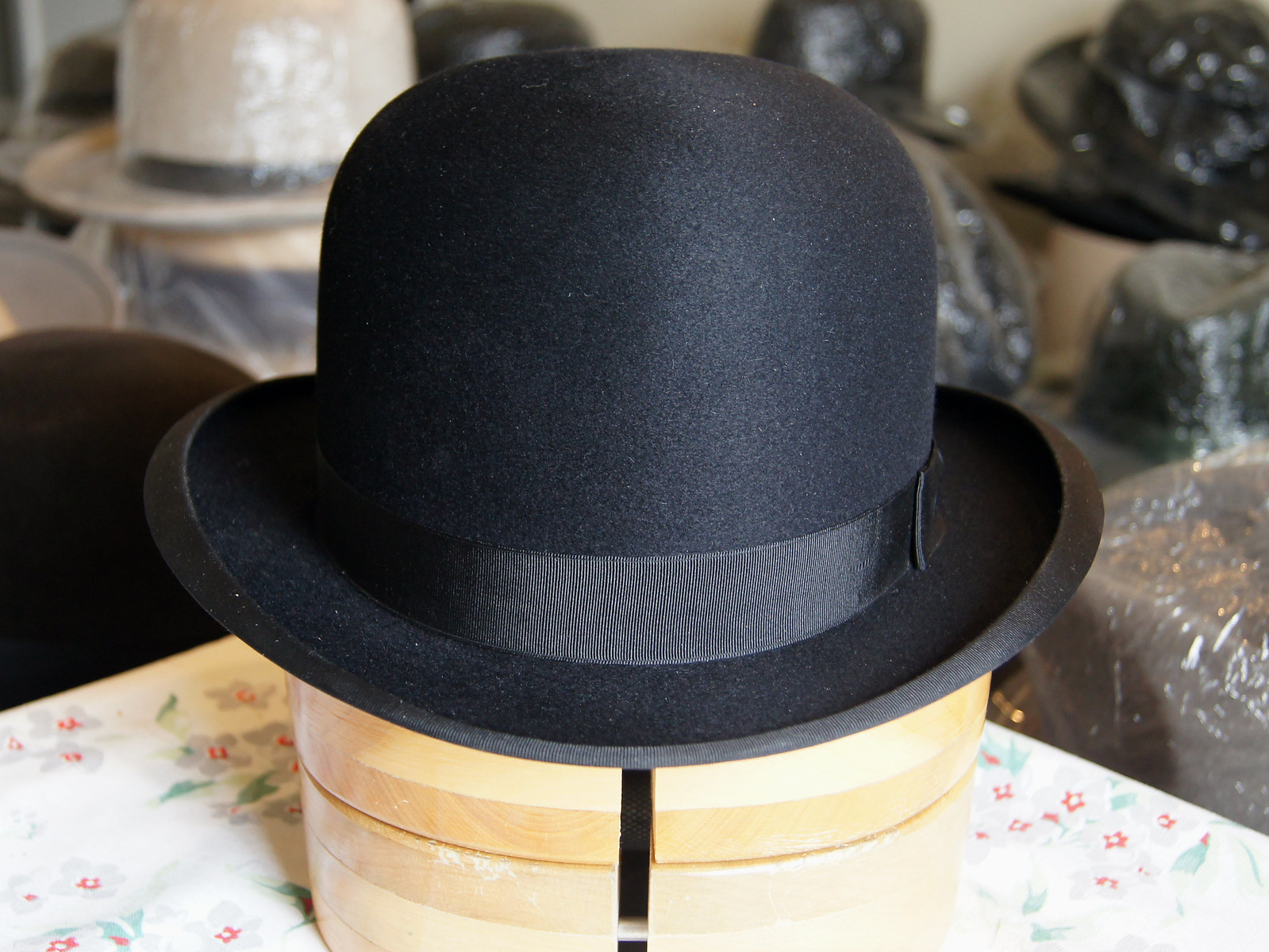


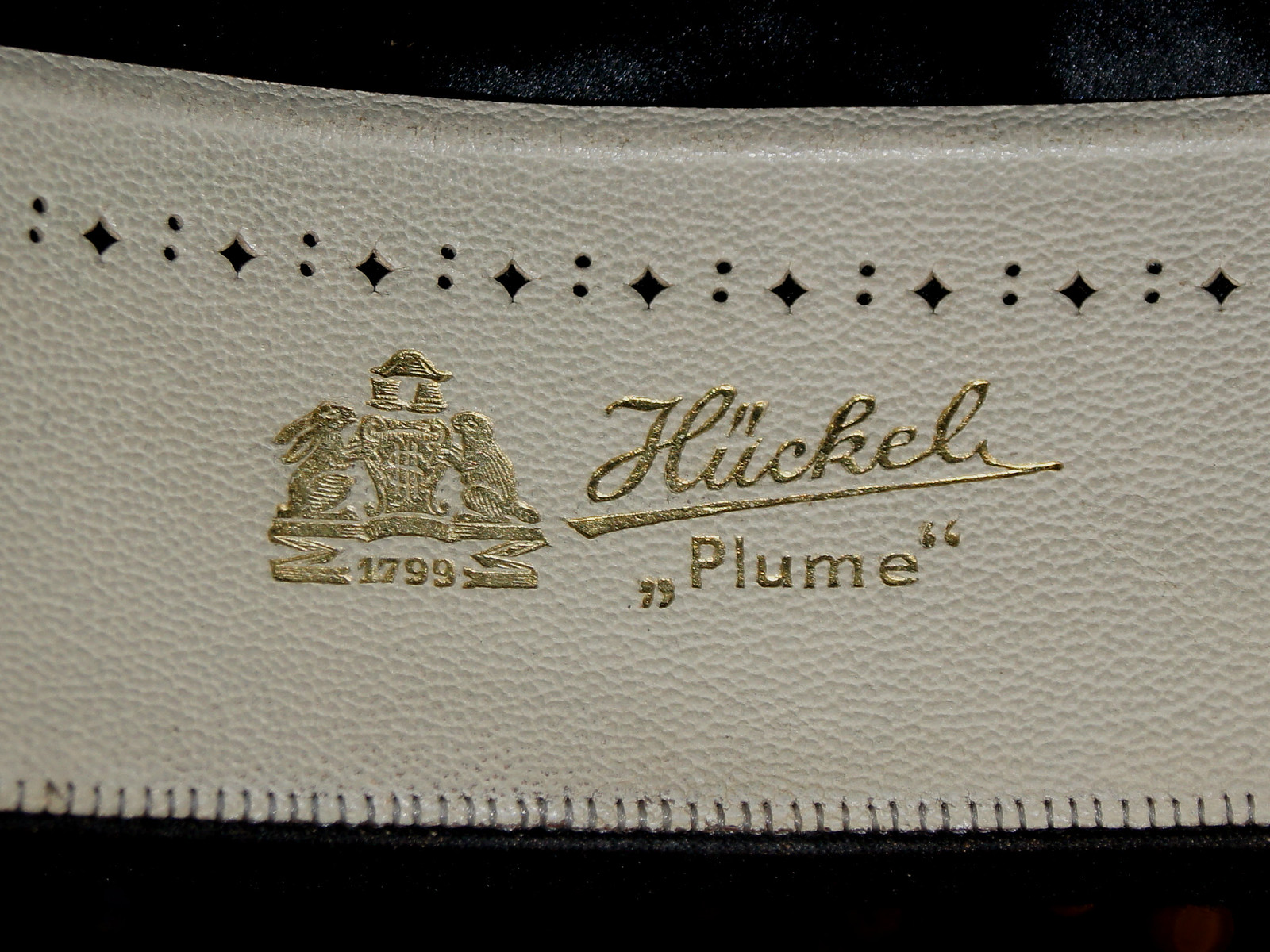

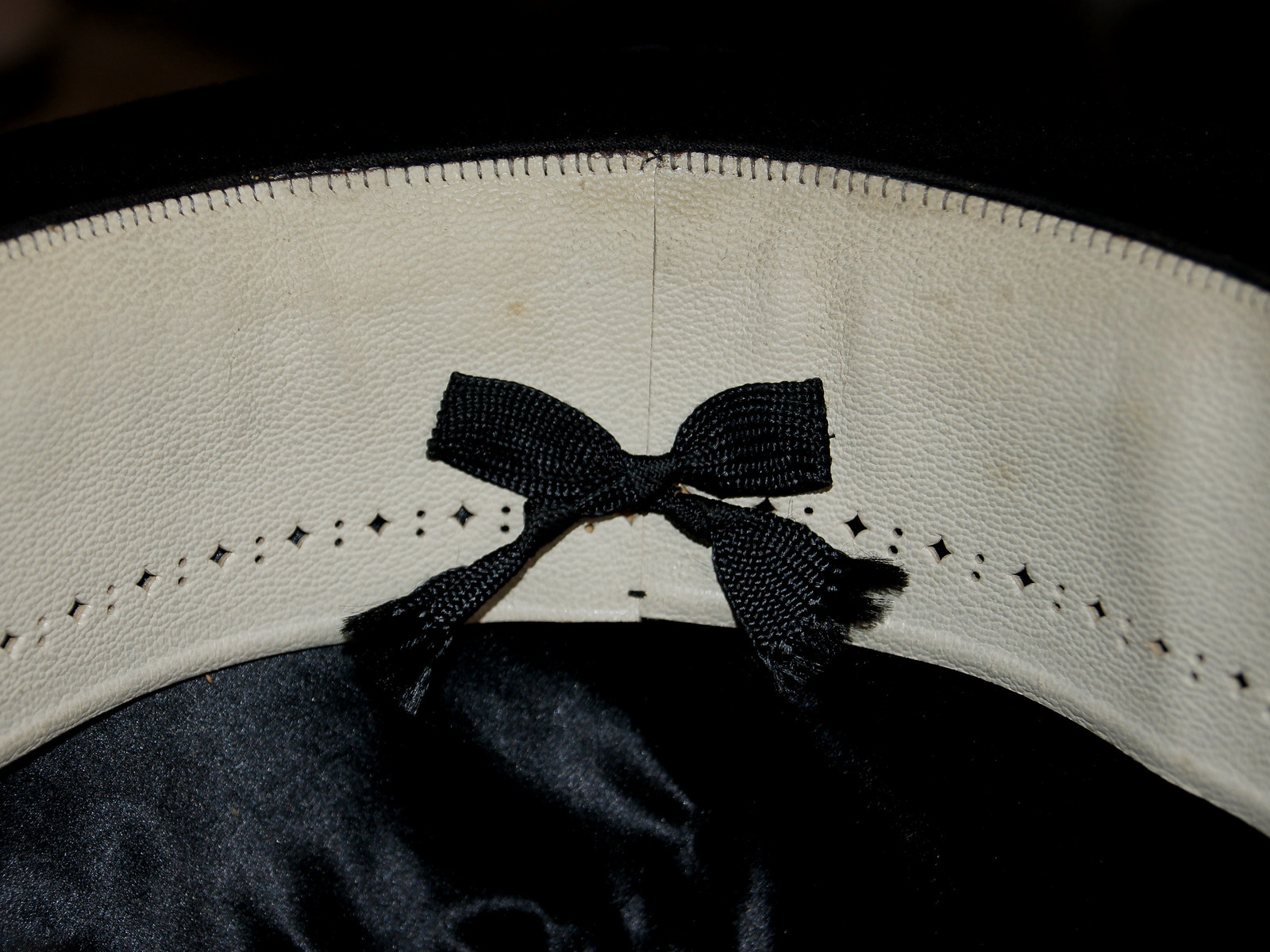
Natural Light
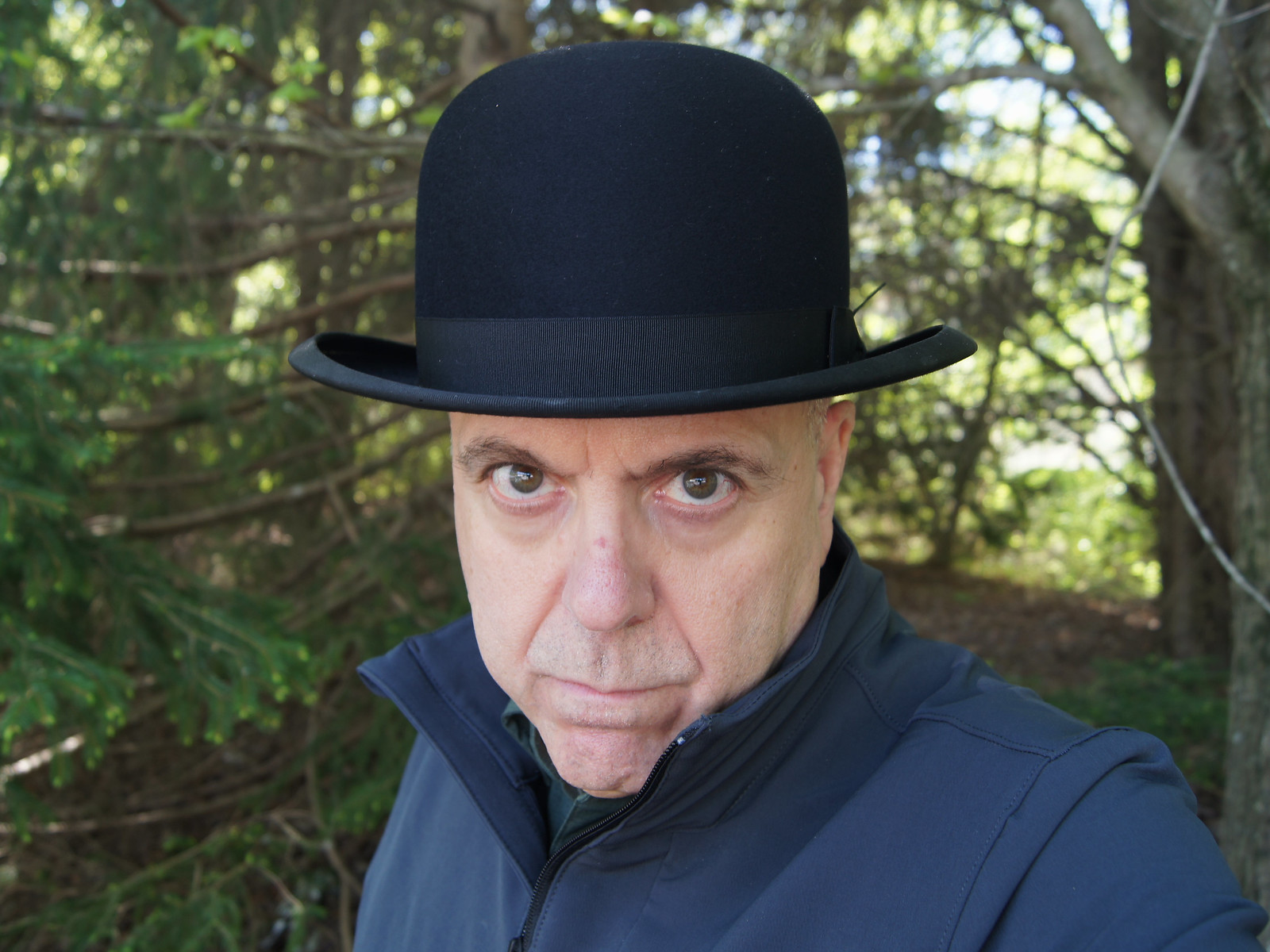
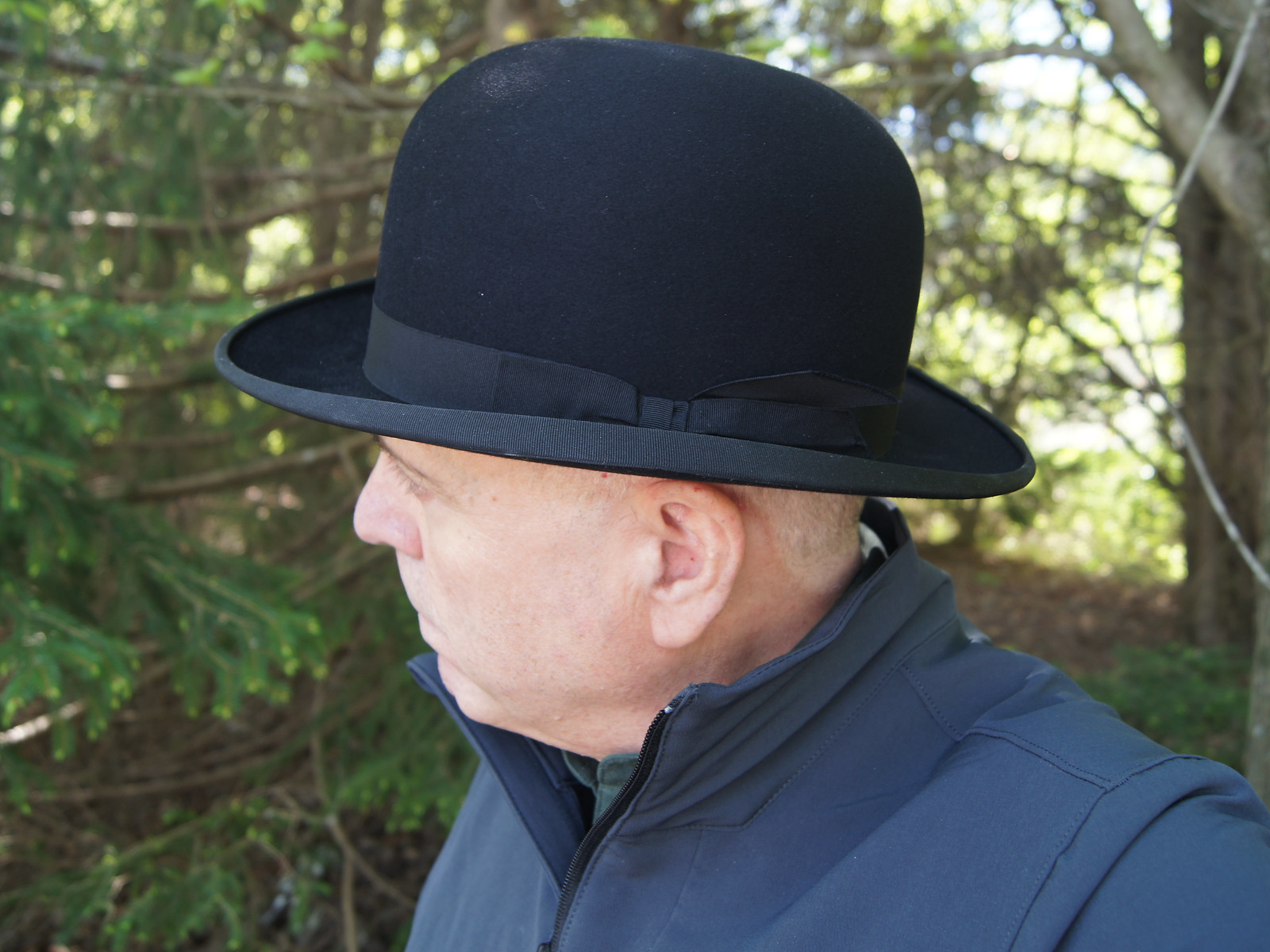
J. Hückel´s Söhne External Pape Size Tag. It was folded at the line and tab placed under the bottom of the Band / Ribbon.

There is only a tiny portion of the Paper Label left.

Vented Spacers were behind the rear of the Sweatband. Their installation most likely caused the missing Paper Label. Highly possible they were supplied to the shop by JHS.

J. Hückel´s Söhne Cardboard Box
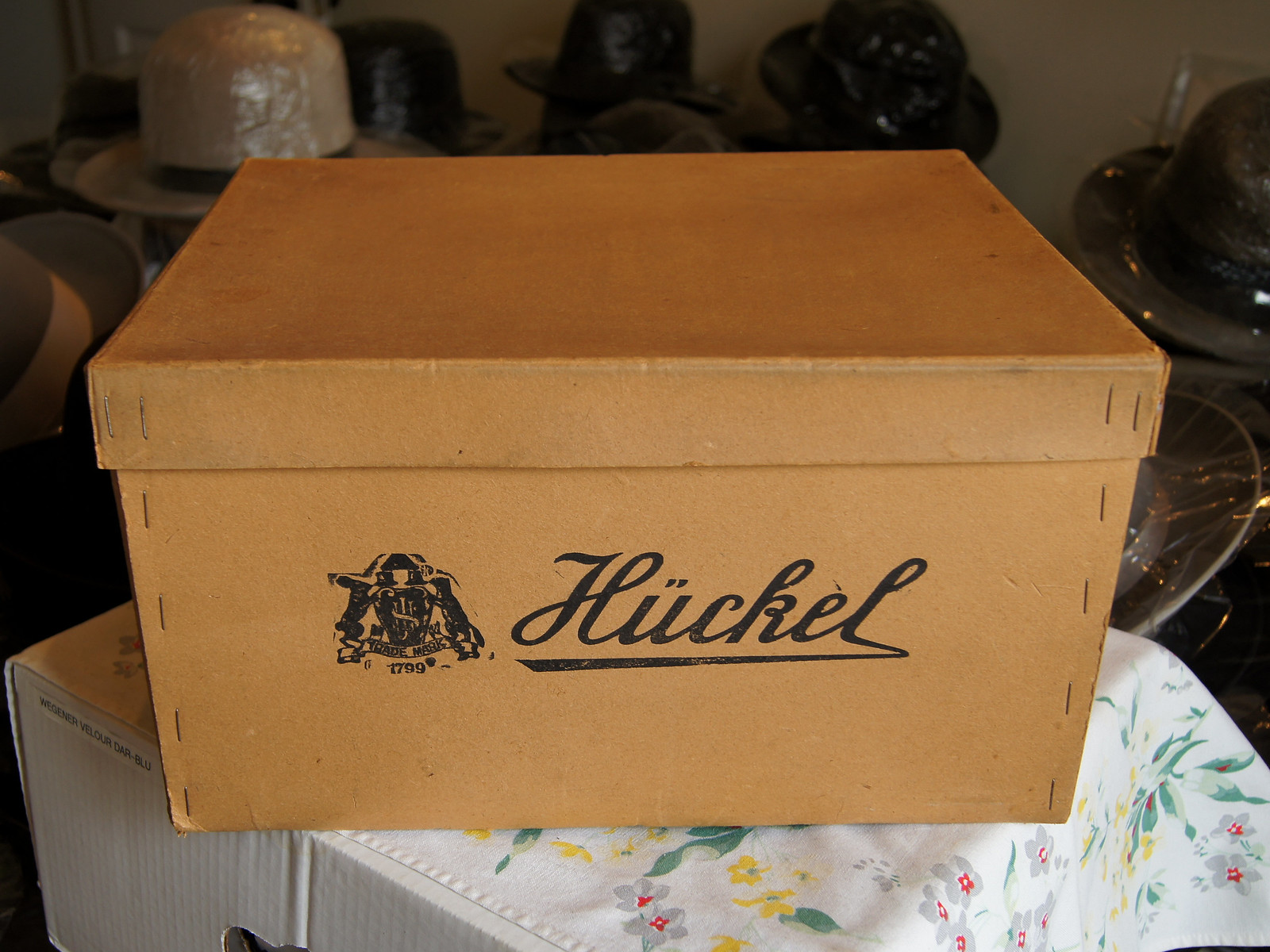


J. Hückel´s Söhne "Plume" surrounded by original tissue paper.
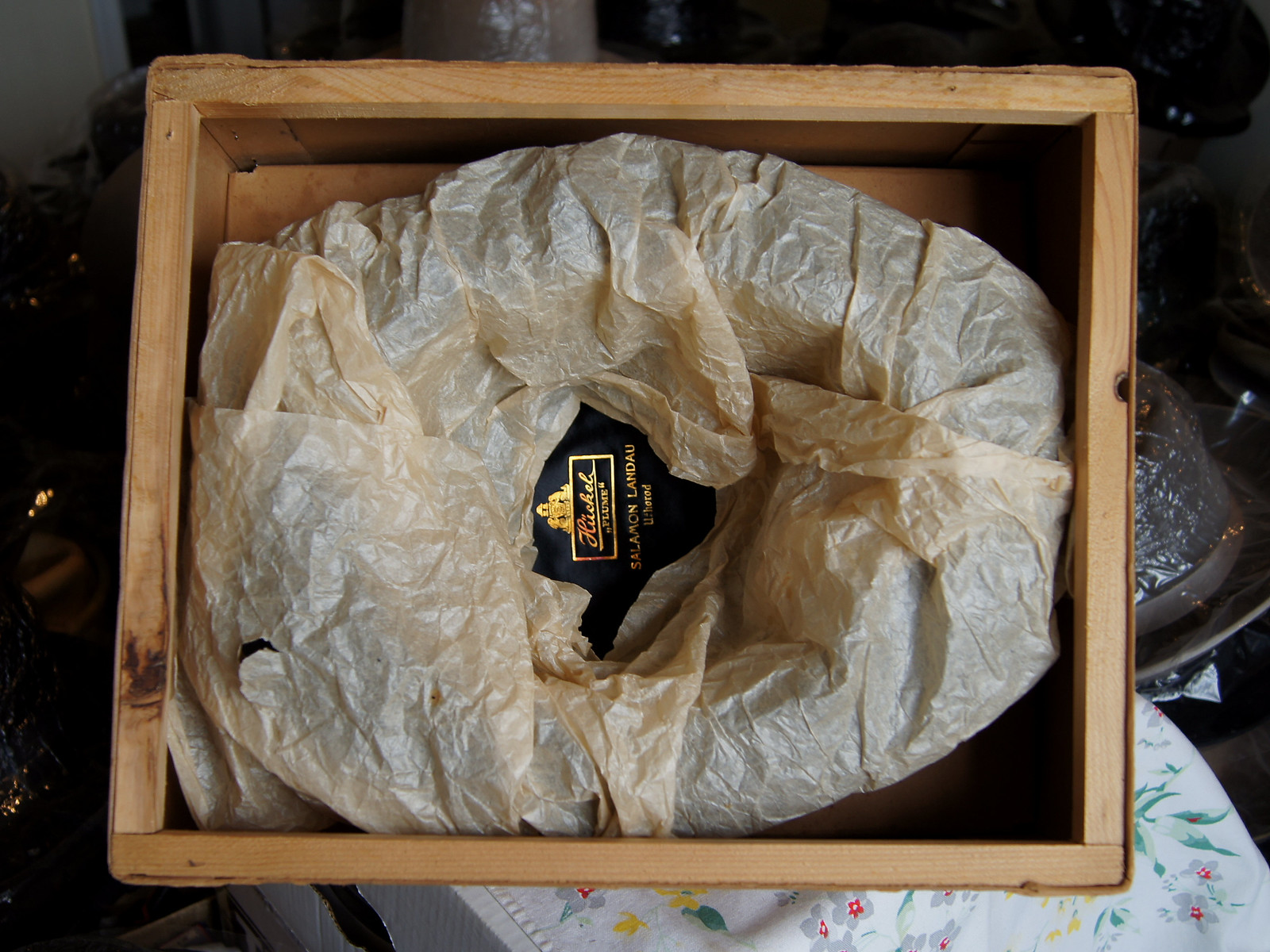
Here are similar J. Hückel´s Söhne Carboard Boxes but from the early 1900s.

-
I received the following message from Jonathan (BruederBoehm) the grandson of Victor Böhm who was the owner and chief inventor at Brüder Böhm Wien, Neutitschein / Novy Jicin.
"I just came across this very interesting article on Brüder Bohm, which I thought you should read. It was published in the latest issue of "Jewish Culture and History" and makes use of the family archive of correspondence that my uncle Henry Bohm (Victor's son, my mother's brother) donated to the Leo Baeck Institute in New York City."
"Letters of loss and urgency: Jewish refugee industrialists, business networks and pathways of rescue" By Dr. Trisha Oakley Kessler, 2022
Abstract
By exploring a collection of business correspondence between Jewish industrialists and their global networks following the expropriation of a large hat factory in Czechoslovakia in 1938. this article sheds light on the complicated and unpredictable nature of human responses to an unfolding moment when Jewish business colleagues faced ruinous economic persecution. Within these letters, these industrialists compose identities that reflect their business selves shaped by their experience of becoming refugees. They also draw out the mechanisms of decision-making in a crisis situation and highlight the concepts of strategy and agency that were crucial to navigating a new social and economic reality.The author, Dr. Trisha Oakley Kessler, was kind enough to let me post a link to the article.
https://www.tandfonline.com/doi/full/10.1080/1462169X.2022.2156190
-

Guben Protected / Well Hatted
Our Hat Industry
By Dr. Kersten
The entire German hat industry, insofar as it is manufactured from scratch, is generally divided into three branches, the felt hat industry, also called wool and hair hat industry, the straw hat industry and the silk and collapsible top hat industry. The latter is based in Altenburg and the first in Bavarian Allgäu, the focus of the German wool and hair hat industry is undoubtedly in the Mark Brandenburg, in particular in Lower Lusatia and in the town of Guben. The felt hat industry in Guben characteristic feature is the production of felt and its processing into a hat. There are pure wool hat companies, pure hair hat companies and companies that produce both types of felt hats, depending on the raw materials processed into felt.
From a historical point of view, the development of the German wool hat industry started in Guben, the place that is still the stronghold of the German felt hat industry today. The fact that there was already a sizeable cloth industry in Lower Lusatia and a workforce that was familiar with the properties and processing of wool as a raw material had a major influence on the development of the wool hat industry in Guben. The preparation of the wool up to the production of the wool pile is the same for the manufacture of cloth and hats. From the headquarters in Guben, the wool hat industry, often based on cloth manufacture, found its way into other areas of the Brandenburg province and later expanded to other parts of the country.
The hair hat industry, i.e. the art of processing hare and rabbit hair into a felt and then into a hat, owes its development to the art of hair cutting and the invention, known since around the middle of the 18th century, of making the hair feltable by treating it with a stain. Haircutting is originally based in Flanders and France, where it was a thriving craft: towards the end of the 18th century it came to Germany; The first branches were in the Frankfurt (Main) area. The first production facilities for hair hats were therefore in southern Germany. It was only later that new foundations emerged in areas of the wool hat industry and currently both branches – the wool hat industry and the hair hat industry – are mostly to be found locally next to each other, due to the need to produce with trained skilled workers.
The Guben felt hat industry traces its origins back to the master hat maker Carl Gottlob Wilke (1796-1875), who was born in Forst and settled in Guben in 1822. Through persistent diligence and skillful adaptation to the requirements of fashion, he managed, despite some setbacks, to convert the original hat maker's workshop into a mechanical operation in 1859 and in 1864 moved to the property where there is still today the hat factory C G Wilke. The invention of C G Wilke, made around 1854 and carefully guarded as a manufacturing secret for many years, was groundbreaking for the art of millinery, to make weatherproof and marketable hats solely from wool, while until then hats could only be made from hare or rabbit hair. The generations of the family that followed him understood how to actively expand the factory, so that it is still one of the largest and most respected companies in the hat industry.
During the 1870s, Apelius Cohn also established a branch of the Berlin-based hat clothing factory in Guben. Under the management of his brother-in-law Hermann Lewin, the company initially dealt mainly with the production of woolen felt hoods, but after just a few years it switched to the production of hats. On January 1, 1888, the company was transformed into the Berlin-Gubener Hutfabrik AG, to which a hair hat factory was affiliated in 1905. In 1907 the merger with Berthold Lißner's large hat factory, which had existed in Guben since 1889, took place. Finally, in 1913, the Berlin-Gubener Hutfabrik AG group was joined by Union Fez Factory G.m.b.H. affiliated as a manufacturer of Turkish Fez. The group of Berlin-Gubener Hutfabrik AG, which manufactures all products of the hat industry, i.e. men's and women's hats in wool, hair and velour, as well as felt hoods, is the largest hat manufacturing company in Germany; and gives a total of about 3,800 people bread and work.
At the beginning of the 1880s, the Steinke company was founded in Guben by the brothers Otto and Gustav Steinke, which developed into a respected hat factory. After multiple changes of owner and company name, it was renamed Gubener Hat Factory AG. While the company was known in the pre-war period for the quality of the stiff hats that were popular at the time, in recent years it has developed and expanded considerably as a women's hat factory. This company also owns the Gubener Hair and Velour Hat Factory AG, which, founded in the post-war period, deals with the production of hair and velour hats.
The hat factory Brecht & Fugmann was founded in 1914 shortly before the outbreak of war as a general partnership and was then called after its founders Brecht & Mathy. Instead of the partner Mathy, Rudolf Fugmann replaced Mathy as a partner in 1920 and since then the company has been called Brecht & Fugmann. In a relatively short time, through tireless work, this company succeeded in joining the ranks of the older companies on an equal footing in terms of the quality of its products and the number of employees.
There are now seven hat manufacturing companies in Guben, which, with 6,500 employees, comprise about two thirds of the entire German felt hat industry.
The wool and hair hat industry, with its ten thousand employees, is of course of little importance within the whole of German industry; but it plays a very important role within the specialist group of the German clothing industry, to which it essentially belongs. In contrast to the cloth industry, for example, it distinguishes itself as a distinctly fashion industry in that it produces a ready-made article which can be used as it leaves the factory. This entails a great complexity of production; because production depends at its roots on the international wool and hair markets, in its further course it is dependent on other industries, e.g. on the silk ribbon and hat leather industry, and in its patterns and new collections it ultimately has to, it wants to be successful, follow the prevailing fashion in terms of shape, color, quality and trimmings or bring out your own new fashion creations. It is therefore necessary to continuously and precisely monitor a large number of the most diverse factors in order to plan correctly and, above all, to have a clear overview of the development of conditions on foreign markets. It is also important to recognize new trends that are emerging in fashion in good time and to use them skillfully for production. This complexity in the running of the business corresponds to a complexity in the labor process; this in itself brings about a strong division of labor. So it happened that today there are almost no more "hat makers" in the old sense, who were made familiar with all the details of the art of hat making through a three-year apprenticeship and were then acquitted by the guild as journeyman hat makers, but that today there are generally "hat workers". who are divided into skilled workers and unskilled workers, who are also hired and trained for a specific activity and then remain in their particular occupation, for the most part on piecework wages. Only through the extensive division of labor, through the most precise control of the manufacture in the various departments from scratch to the finished hat, through trying out new techniques and through the complete exertion of all forces, has the Gubener hat industry succeeded in producing a product of such high quality as it is today's hat that indisputably enjoys the best reputation on the German hat market.
However, the Gubener hat industry does not only hold a leading position because of the quality of its products, but also in terms of numbers it ranks first in Germany in terms of production. It is estimated that it produces around ten million men's and women's felt hats a year. Even though there is a certain proportion of semi-finished products (so-called felt hoods), one can rightly claim that at least every second felt hat of German origin that is worn in Germany comes from Guben. But the hat industry is not limited to domestic deliveries, but the saying always applied - before and after the war: "My field is the world!" There is no continent that is not supplied with Gubener hats and exports goes not only to countries with little hat industry, but also to countries with the greatest technical ability and strongest competitiveness.
Of course, extraordinary difficulties had to be overcome after the war in order to get the lost exports going again and to gain new ground on the former foreign sales markets, especially since in individual competing countries the domestic industry there - similar to our hair hat industry - during the war technically very much improved and had become extraordinarily efficient. However, the tenacious efforts of the entrepreneurs succeeded in increasing exports to such an extent that in the years 1927/28 they reached 80 per cent in value of the total production. Unfortunately, the economic crisis brought about a change. The devaluation of many European currencies has exacerbated this over the past few years; After the North American market had been blocked some time earlier by the introduction of high protective tariffs for German imports, the devaluation of the pound sterling in particular made the hitherto considerable exports to the Nordic countries and to England itself almost impossible. The export share fell to half, that is to 15 per cent, of the total production, and figures can be used to show that the reduction in the number of employees which occurred during the crisis can be attributed exclusively to the drop in exports. In other words: throughout the crisis, the Gubener hat industry maintained its domestic sales in terms of employment. Certainly an achievement to be proud of and of which entrepreneurs and followers can be proud! Of the 48 hat factories in Germany in 1928, the crisis swept away 12, i.e. a quarter, so that in 1934 only 36 were still in existence. Only one of the twelve factories that were shut down was in Guben, so that at the time our town was often described as an economic oasis.
For various reasons, the National Socialist state's vigorous job-creation measures could not have a direct impact on the hat industry. They had to be aimed at the big picture, that is, cover those trades that could accommodate the largest possible number of workers, so that they could not be geared to the special conditions of such a narrow special industry. Then there was the fact that the hat is not part of a uniform, so that there was no animation from this side either. In addition, the hatless fashion that had existed for years continued to have a very detrimental effect on employment. So in the hat industry a certain improvement only became noticeable in the second half of 1934.
With around 6,500 employees, the hat industry is the largest provider of jobs for the commercial population of the town of Guben. If it were possible to increase exports more strongly again, a further large number of jobs could be filled; the number of employees in October 1927 was almost 7500!
The wool and hair hat industry is an industry that involves a great deal of labor, because it first produces a semi-finished product (so-called felt hoods) from the natural raw material (wool, noils, rabbit and hare hair) and then immediately afterwards produces the finished product from the semi-finished product, which as it leaves the factory, is used by the consumer. Men and women work in roughly equal proportions (46 to 54 percent). The decisive factor for the large number of female followers is the fact that on the one hand the material in the first steps requires more delicate processing by the lighter woman's hand and on the other hand the hat stitching and trimmings with their many sewing tasks are typical women's work.
On average, about 60% of the employees are pieceworkers.
If you estimate the sum of all wages and salaries that the Gubener hat industry pays per year, you still arrive at an amount of around 8 million Reichsmarks today (compared to a high of 12 to 13 million marks in 1927). If you take into account that the approximately 6,500 employees each support one relative from their earnings, then there are around 13,000 Guben residents who earn their livelihood directly from the hat industry.
From these figures it follows that the hat industry is the characteristic industry for Guben and that Guben is rightly called the "Hat City of Germany".
(This article was provided by Marting81.)
-
 1
1
-
-
Franz Richter & Söhne, Dresden,"Küssnacht" "Tell", 57 cm, Wool possibly 1930s. I very much like finding old German Wool Soft Felt Hats this one. This Soft Felt could have been made by one of the German Hat Factories (located in what became East Germany post WWII) that produced Wool Soft and Stiff Felt hats up to WWII. It could have also been made by FRS from sourced Wool stumps from the same sources. The Liner is extremally light weight so very delicate. This is probably the reason the two other FRS Soft Felts (belong to Matt and Stefan) are missing their Liners. The wide 7 cm Curled Brim is mildly flanged.

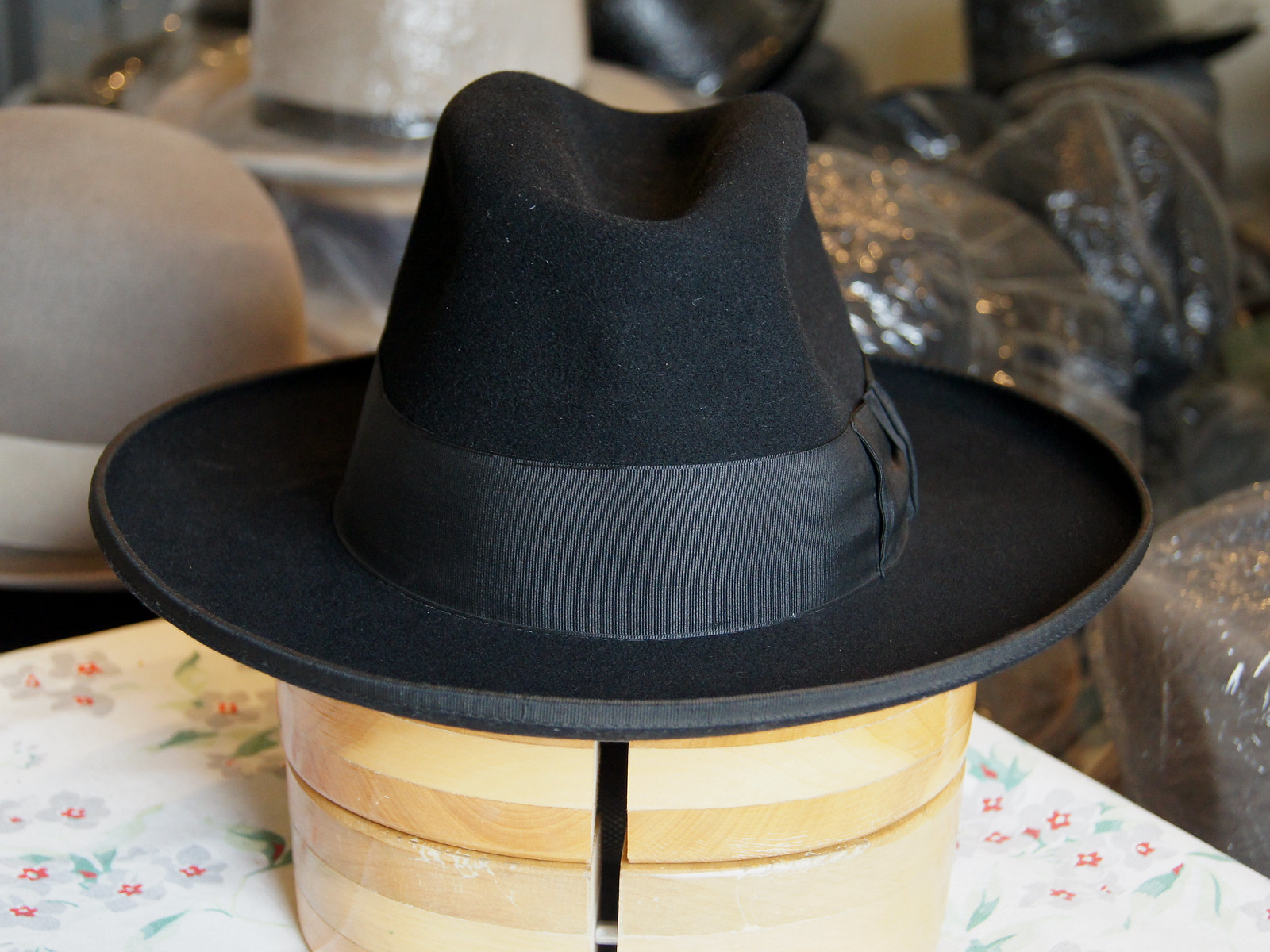
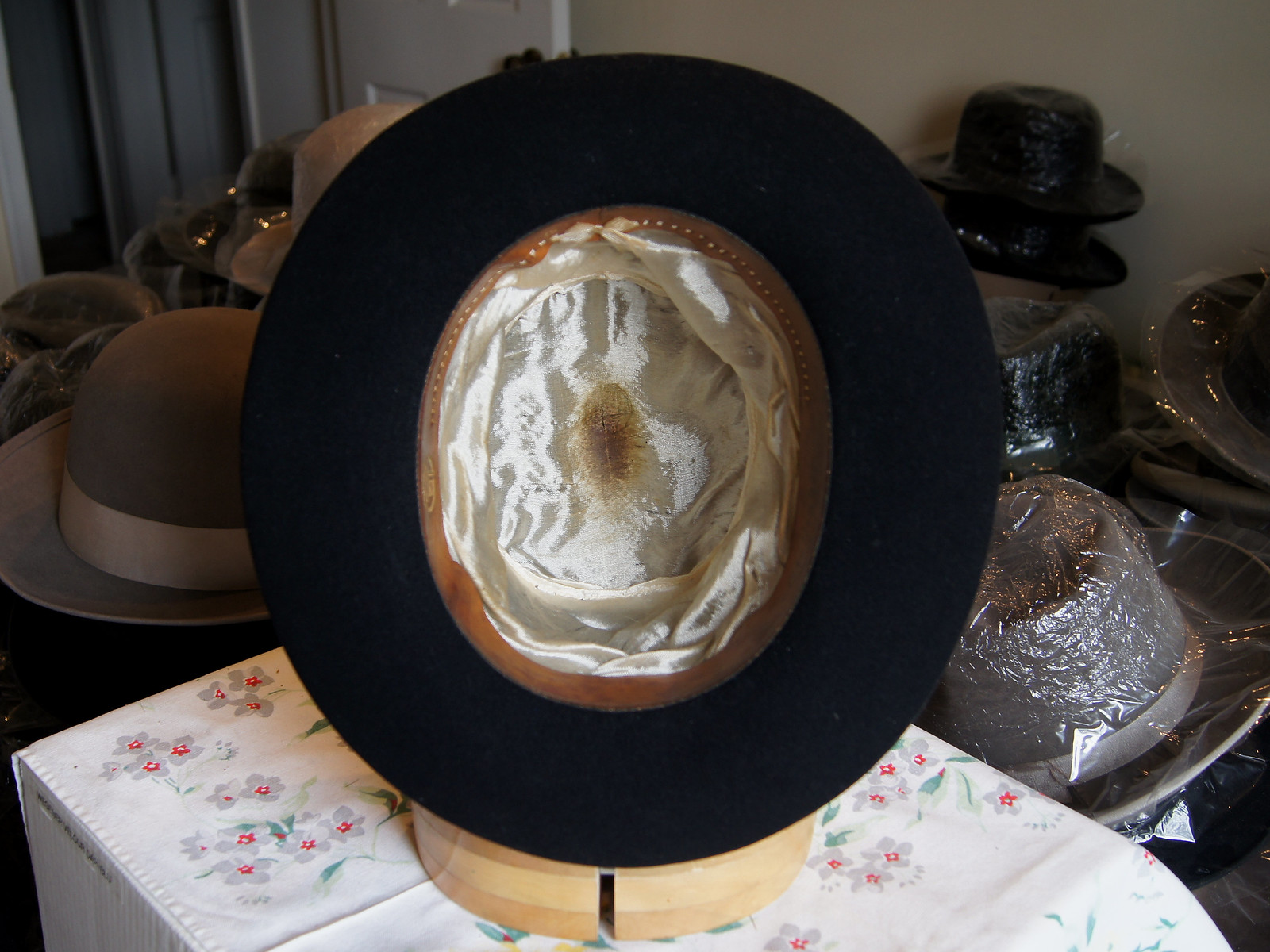
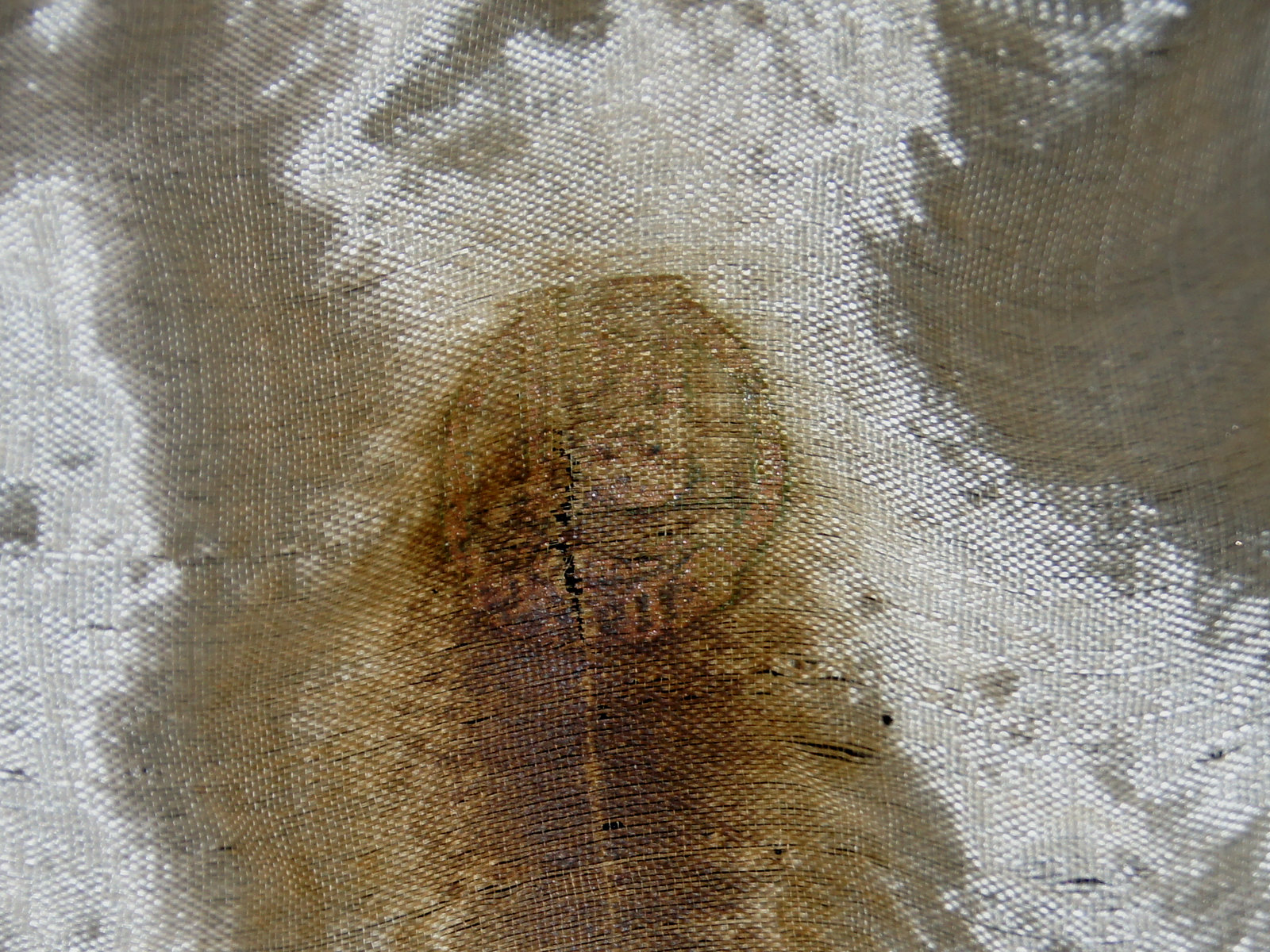
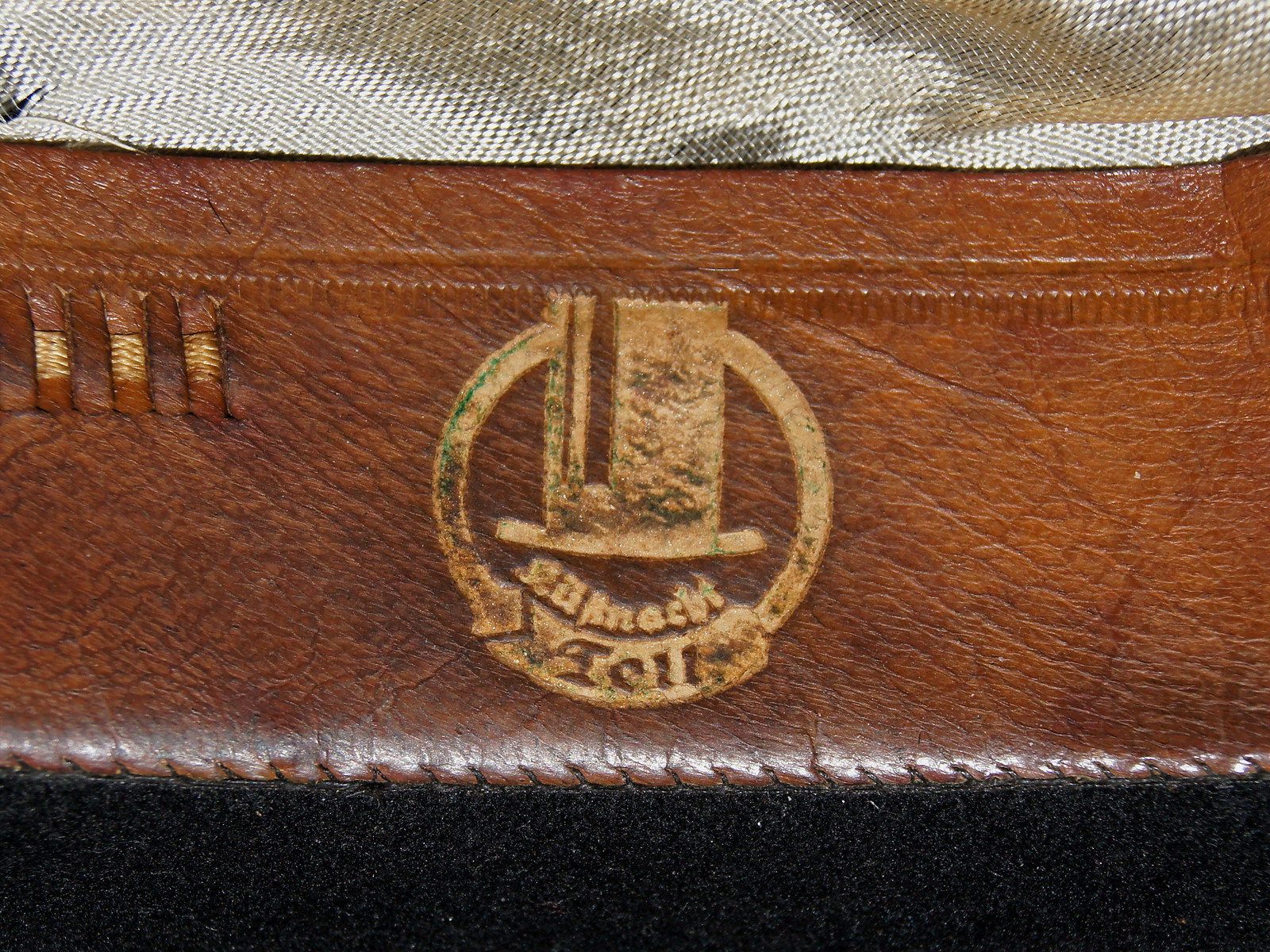
Owner's Handwritten Surname. This a note from Gertrud the seller of the hat. "The hat is from my grandpa Franz-Xaver Schellinger. He died in 1954 and I never got to know him. He probably bought the hat in the 20's or 30's. Definitely before World War II."
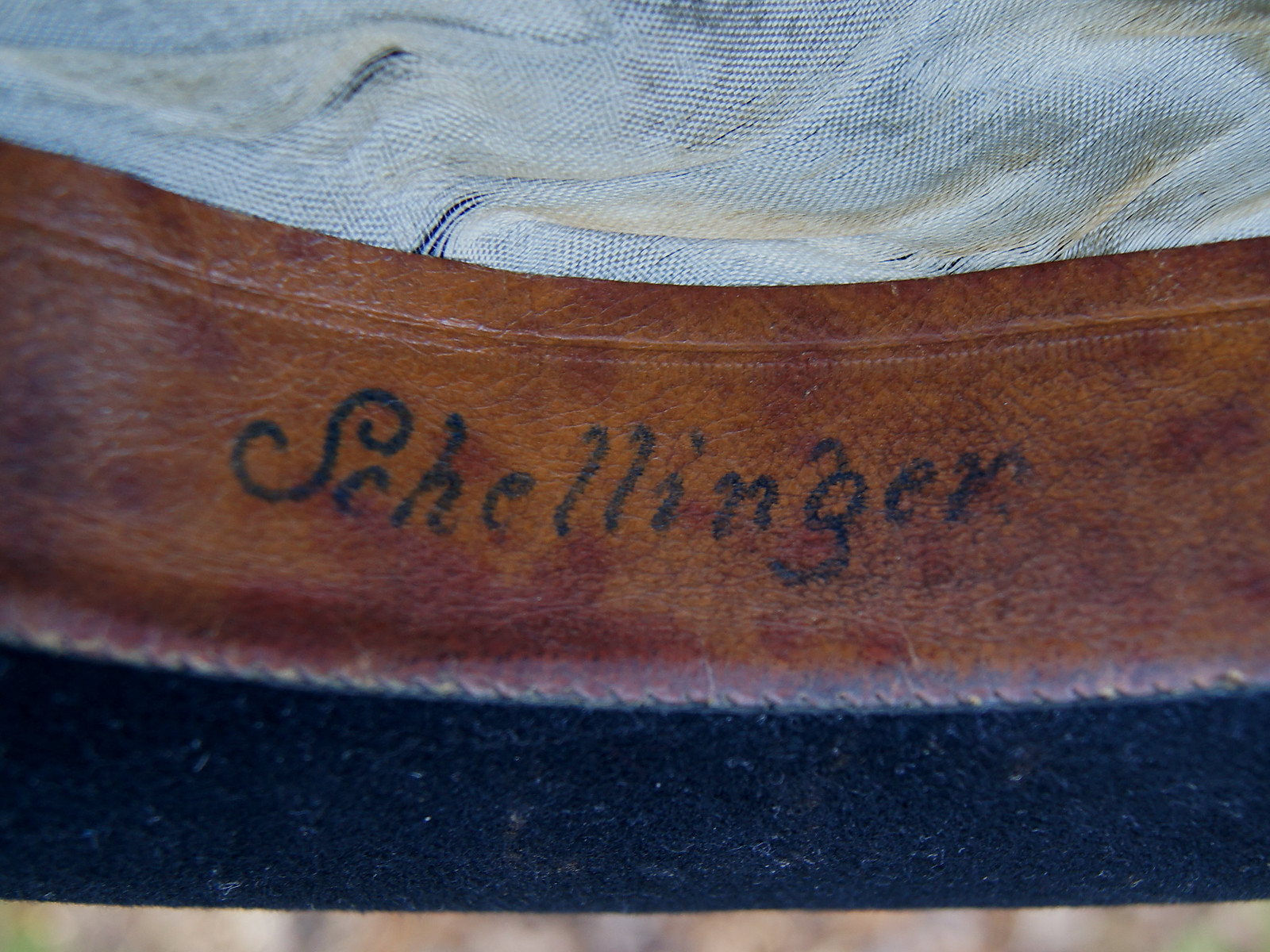
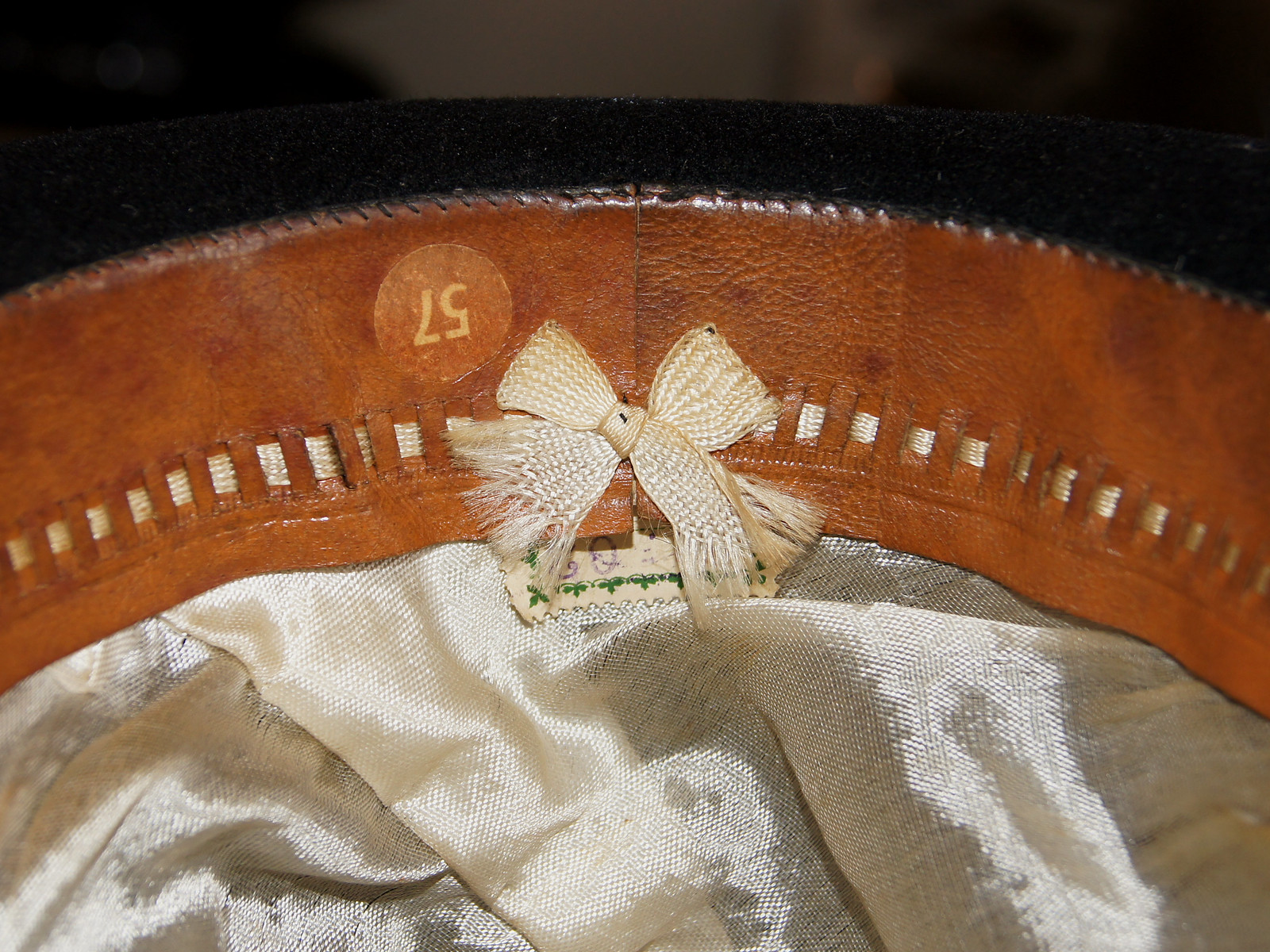
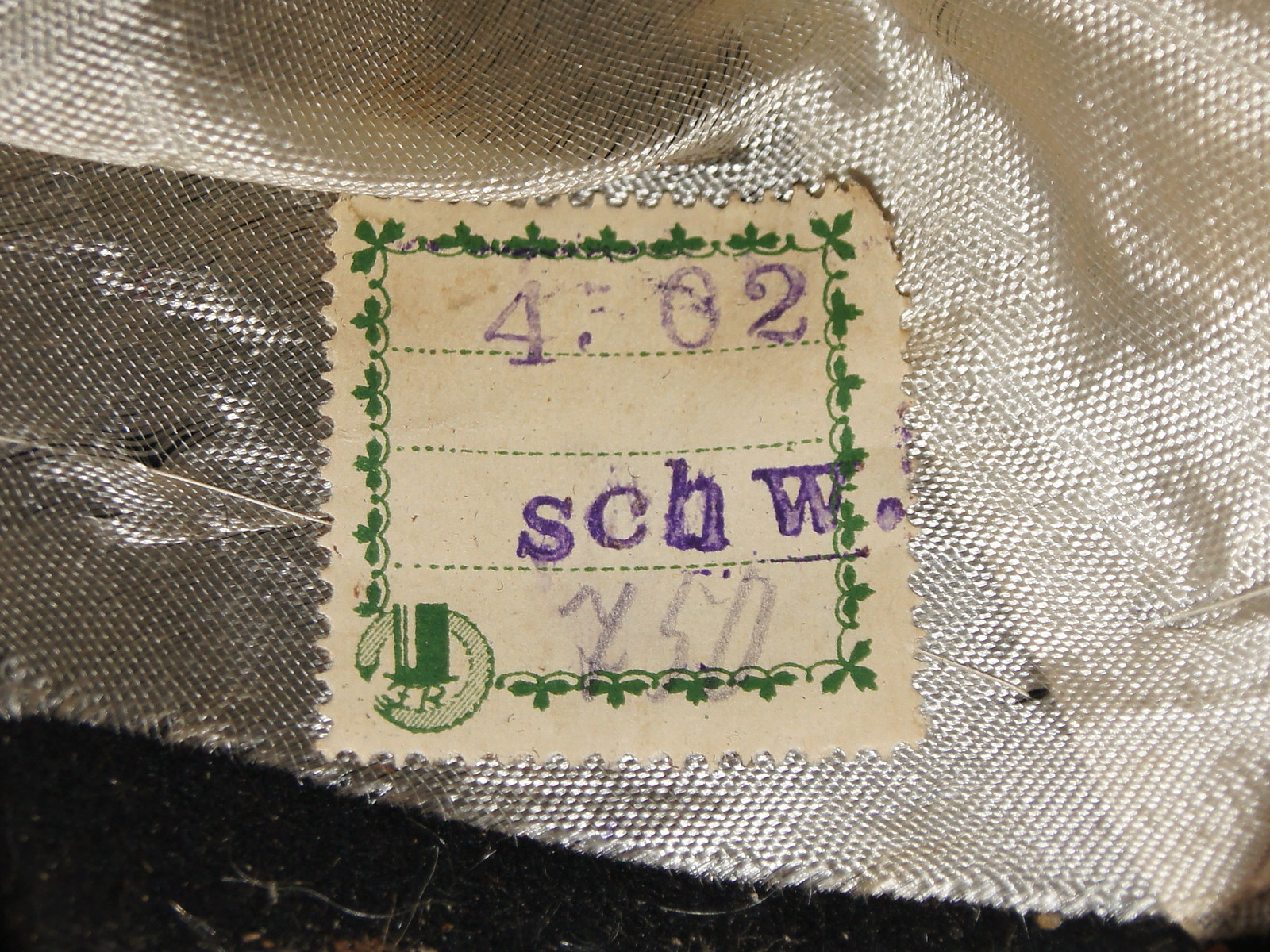
Open Crown

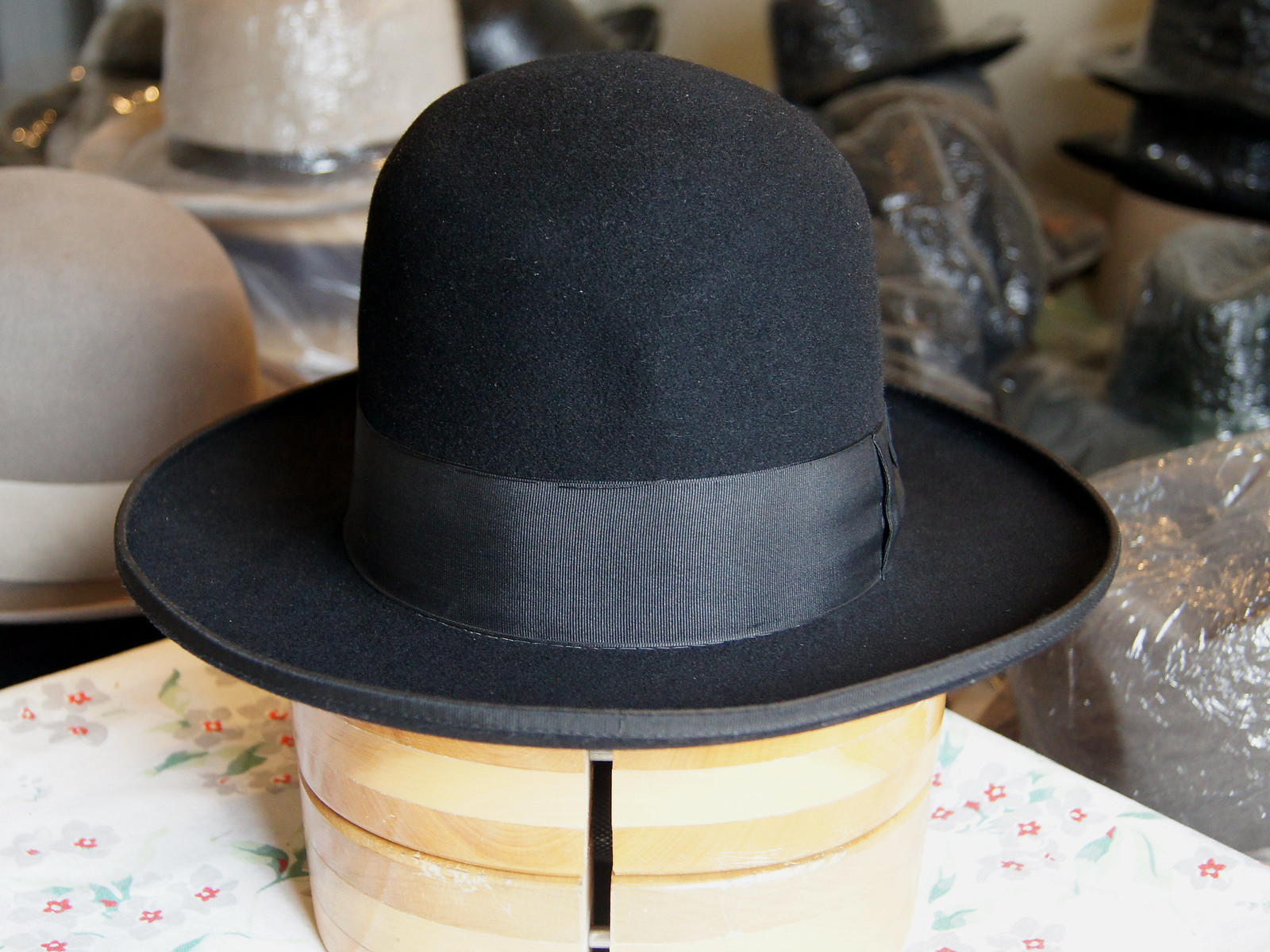
Natural Light

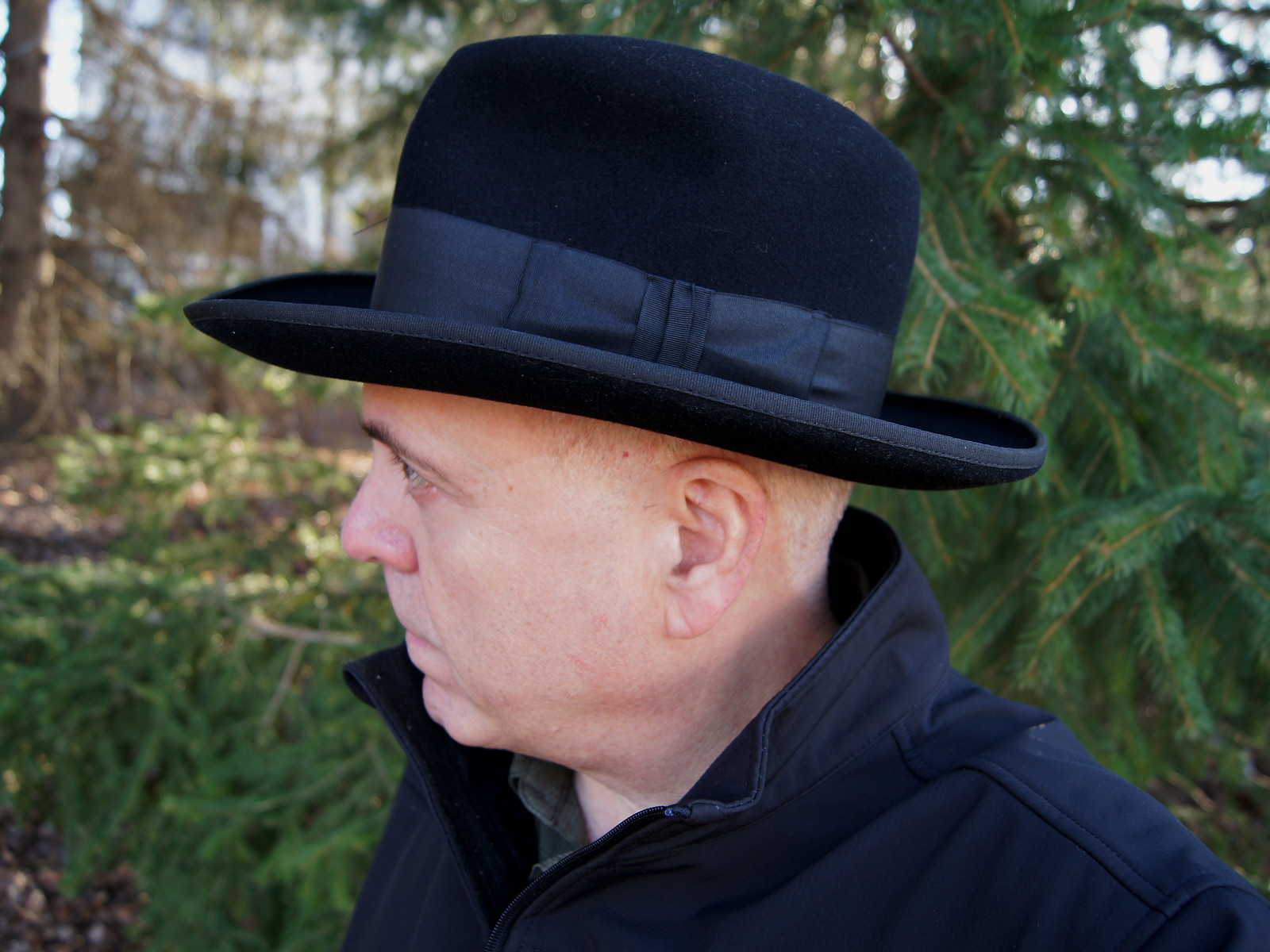
-
"Deutsches Fabrikat", 58 cm, 119 grams, possibly 1930s. No company labels so most likely sourced by the shop Emil Fischer Dortmund (see Case below). The Black Fur Felt has a unique Chamois Finish with a very soft Hand. The condition is near NOS condition which along with the Finish attracted me to this Stiff Felt.
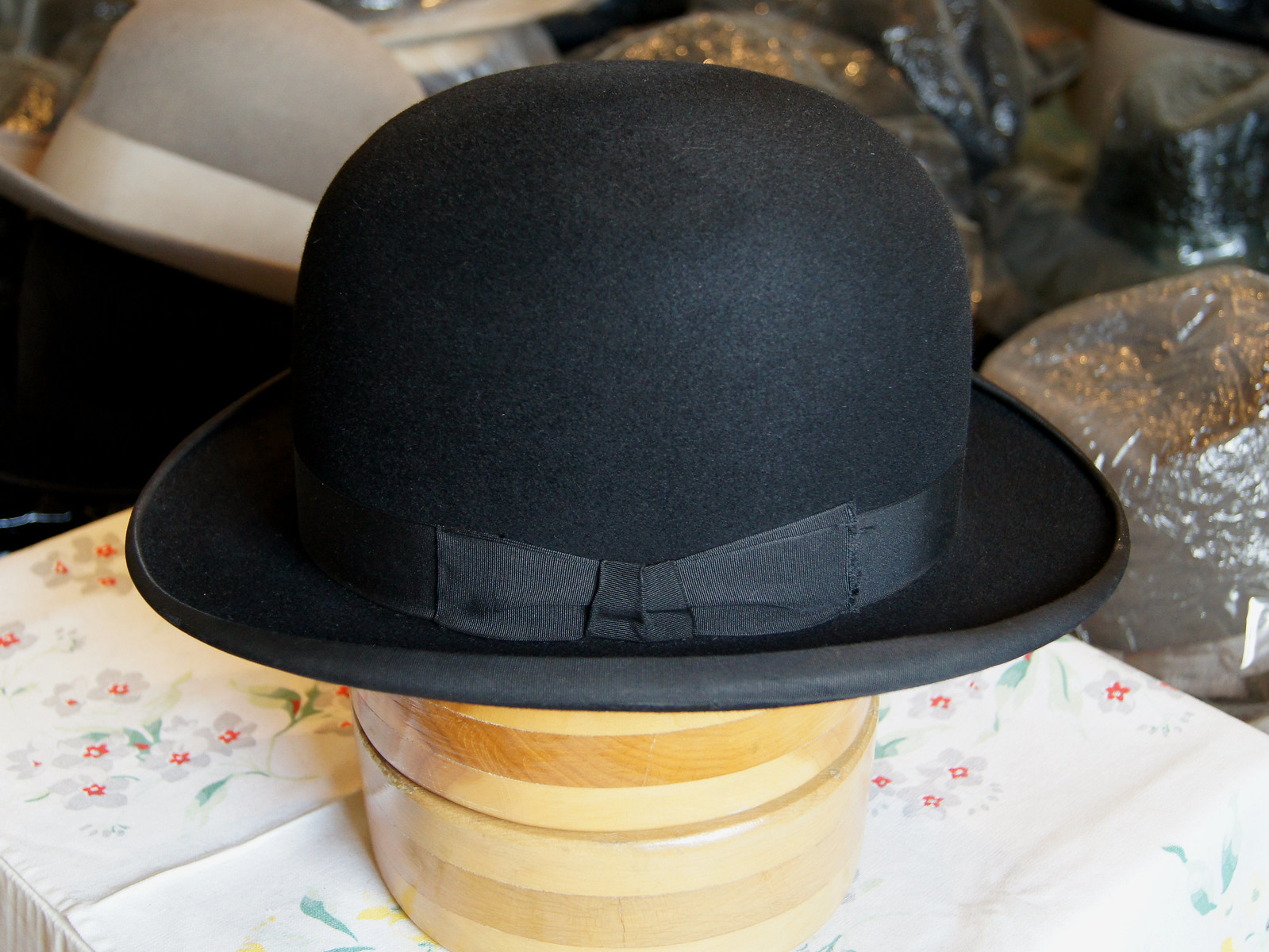
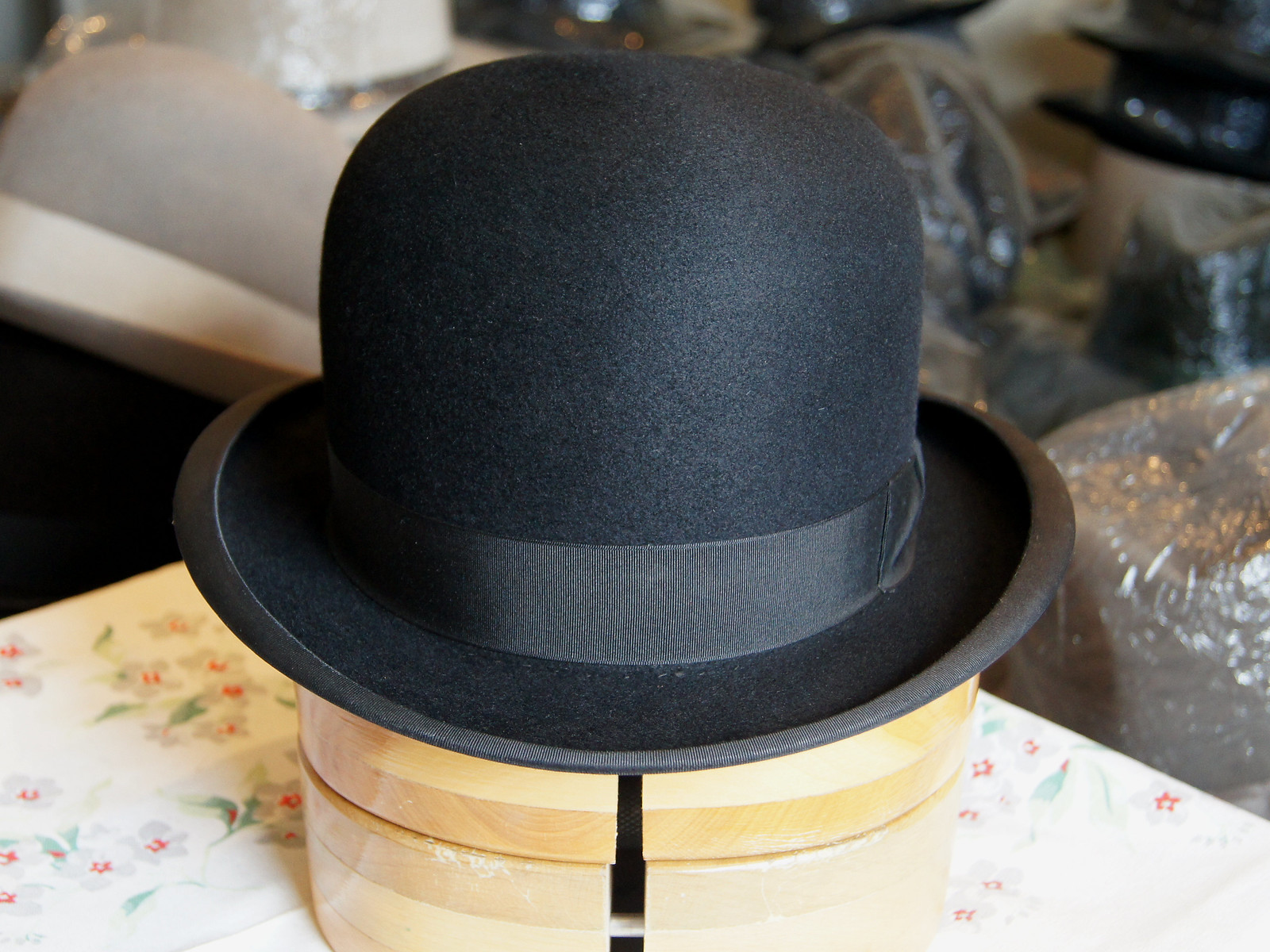



Original Case, Emil Fischer Dortmund Wiss - Str 26 - 28
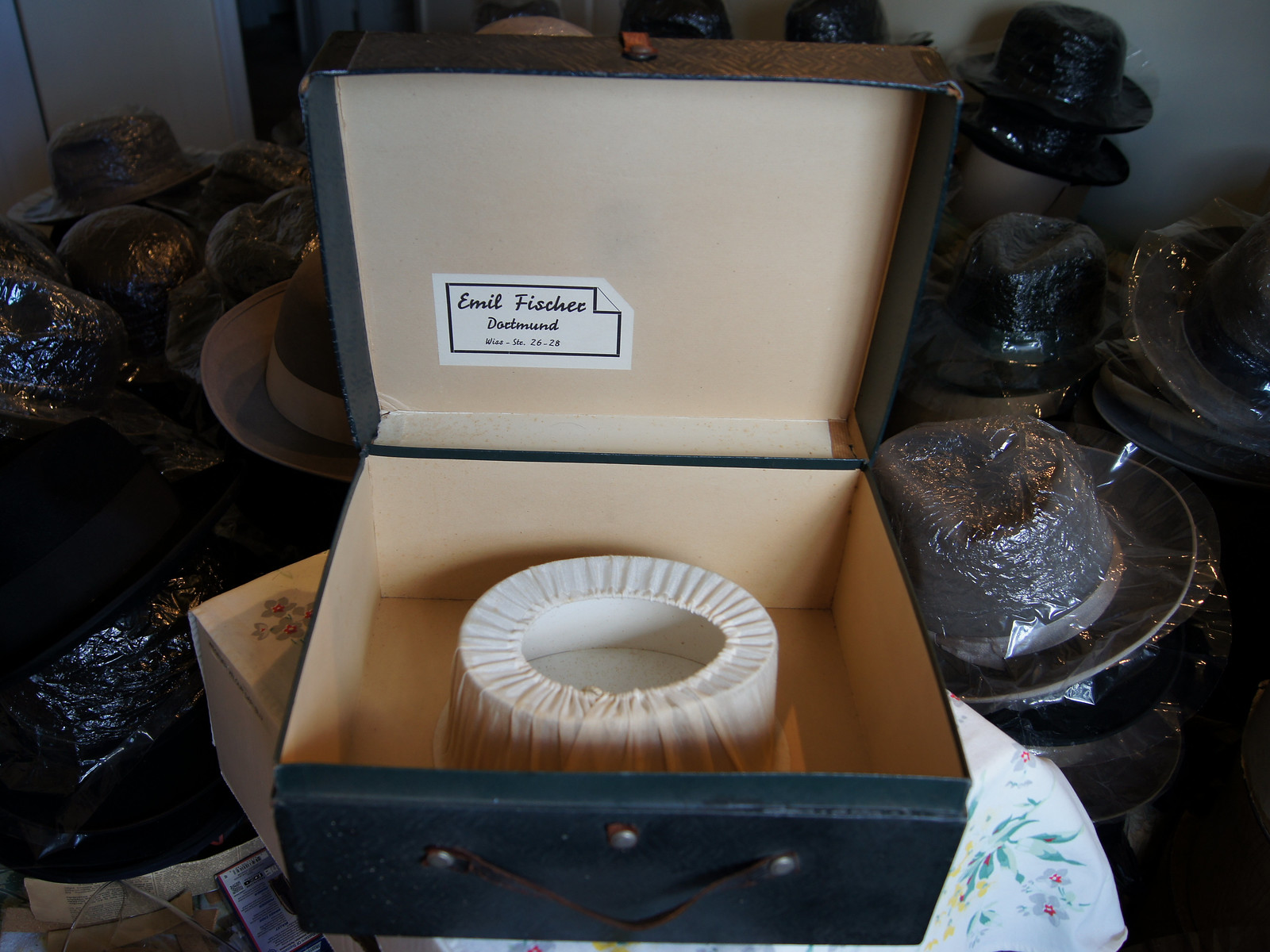

-
"Deutsches Fabrikat" is the only Trademark. No German Hat company information. Most likely sourced by a distributor or hat shop.
-
P. & C. Habig Wien "Special", P. & C. Habig's "Special Qualität, Reine Handarbeit", 58 cm, possibly 1930s late 1920s and reworked later. There is no paper label but the Liner is stitched in so if reworked it was possibly in the 1950s. The Felt has a Natural finish but a soft hand. The Sweatband, Liner and Band are of very high quality.




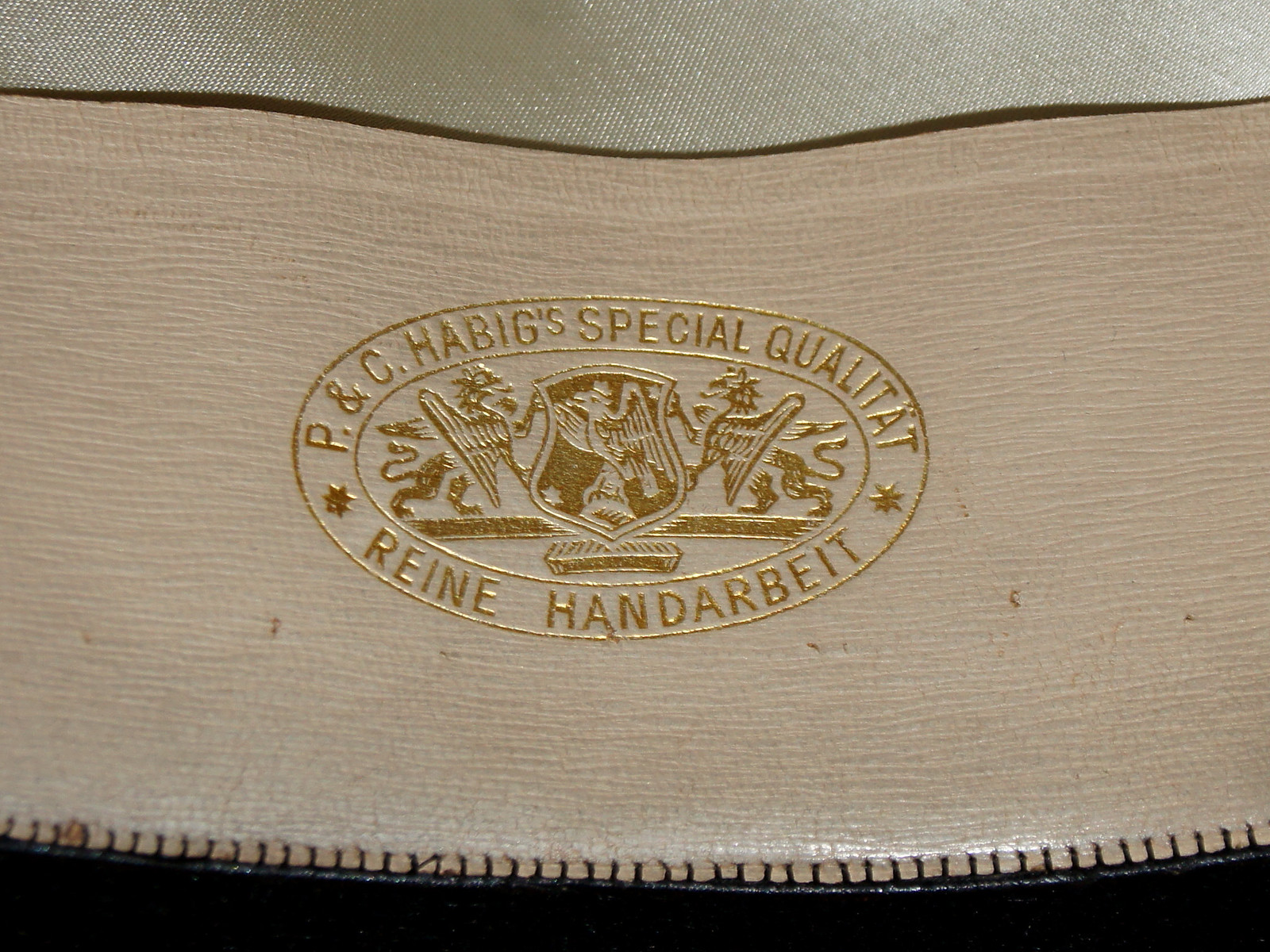

Open Crown
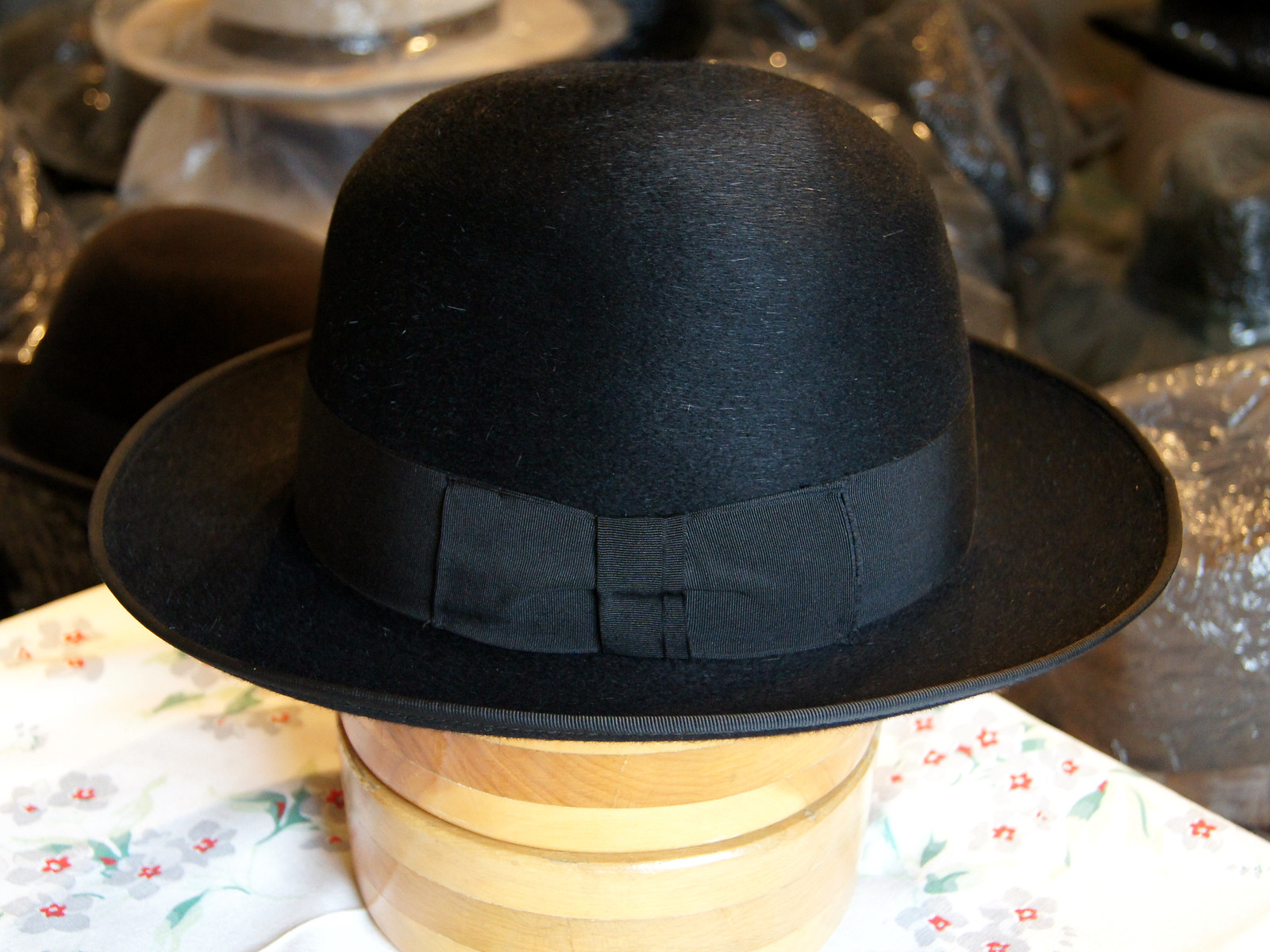

Natural Light


-
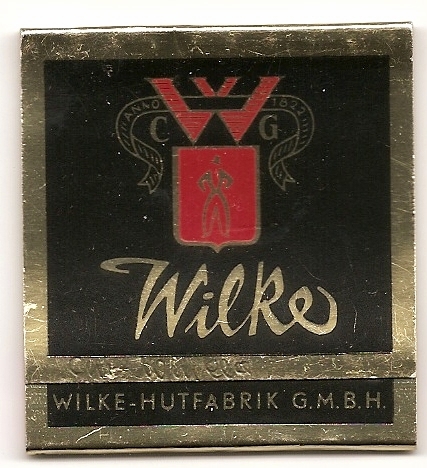
Teleurope, Volume 23 1979, Page 359
Wilke Hutfabrik GmbH , Königreichweg 7 , D - 844 Straubing

-
Hat Maker Family Wilke - Benefactors and Donors
https://themator.museum-digital.de/ausgabe/showthema.php?m_tid=567&tid=592&ver=nat
English Translation



















Mayser Hutfabrik
in German Hat Companies
Posted
Stetson "Excellent" "Bloulevard" Made under License by Mayser Ulm, Especially Made for Hut Seidl München (Mayser Ulm's Flagship Store), date stamped 02/57 and 4. März 1958. Superb overall quality and workmanship as expected. Also in Excellent condition. Interesting that there are two date stamps. Mayser started licensing and making Stetson Hats in 1954. I would like to thank Regine of Steinhagen, Germany for selling + sending my this fantastic Homburg Hut!
condition. Interesting that there are two date stamps. Mayser started licensing and making Stetson Hats in 1954. I would like to thank Regine of Steinhagen, Germany for selling + sending my this fantastic Homburg Hut!
Open Crown
Natural Light